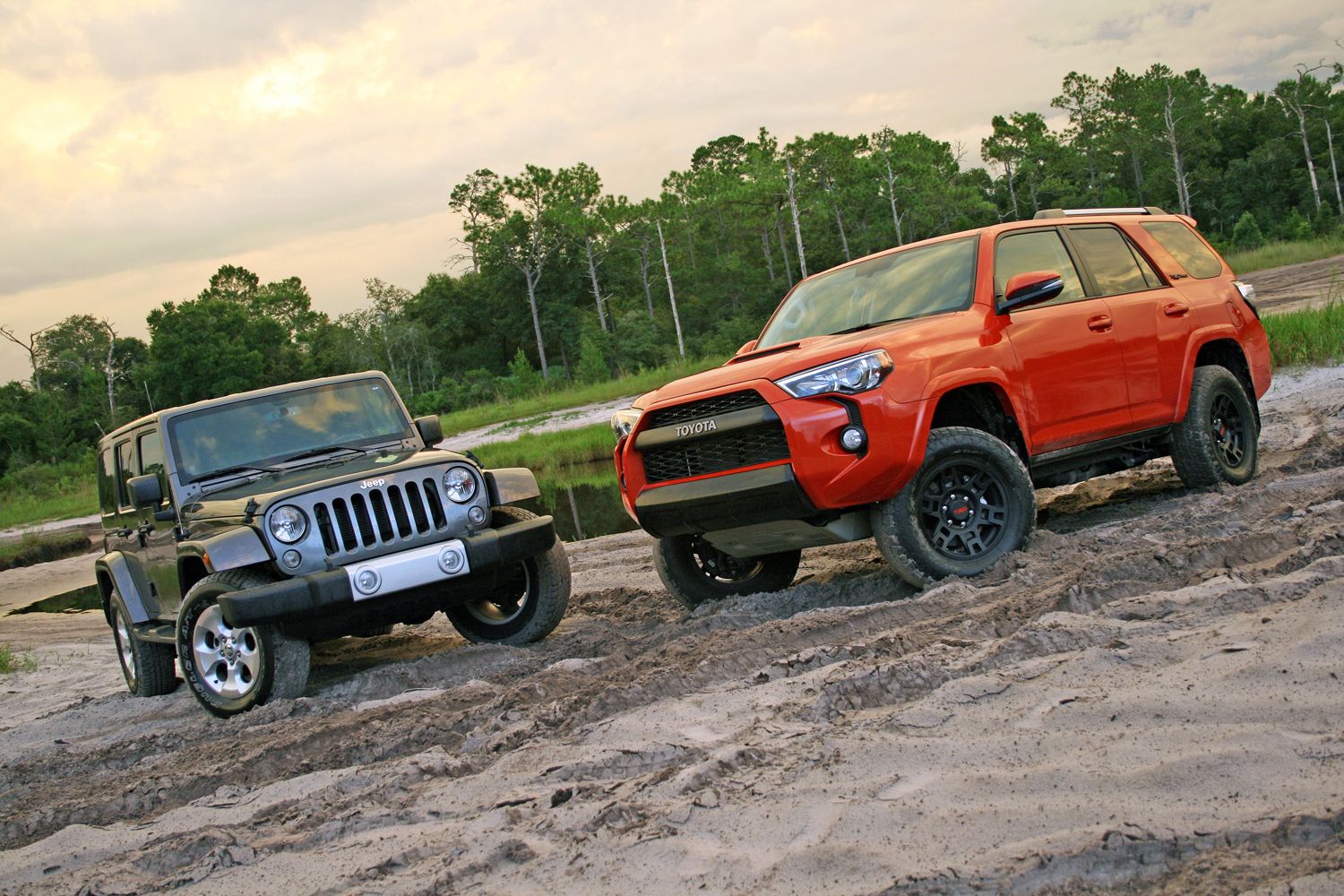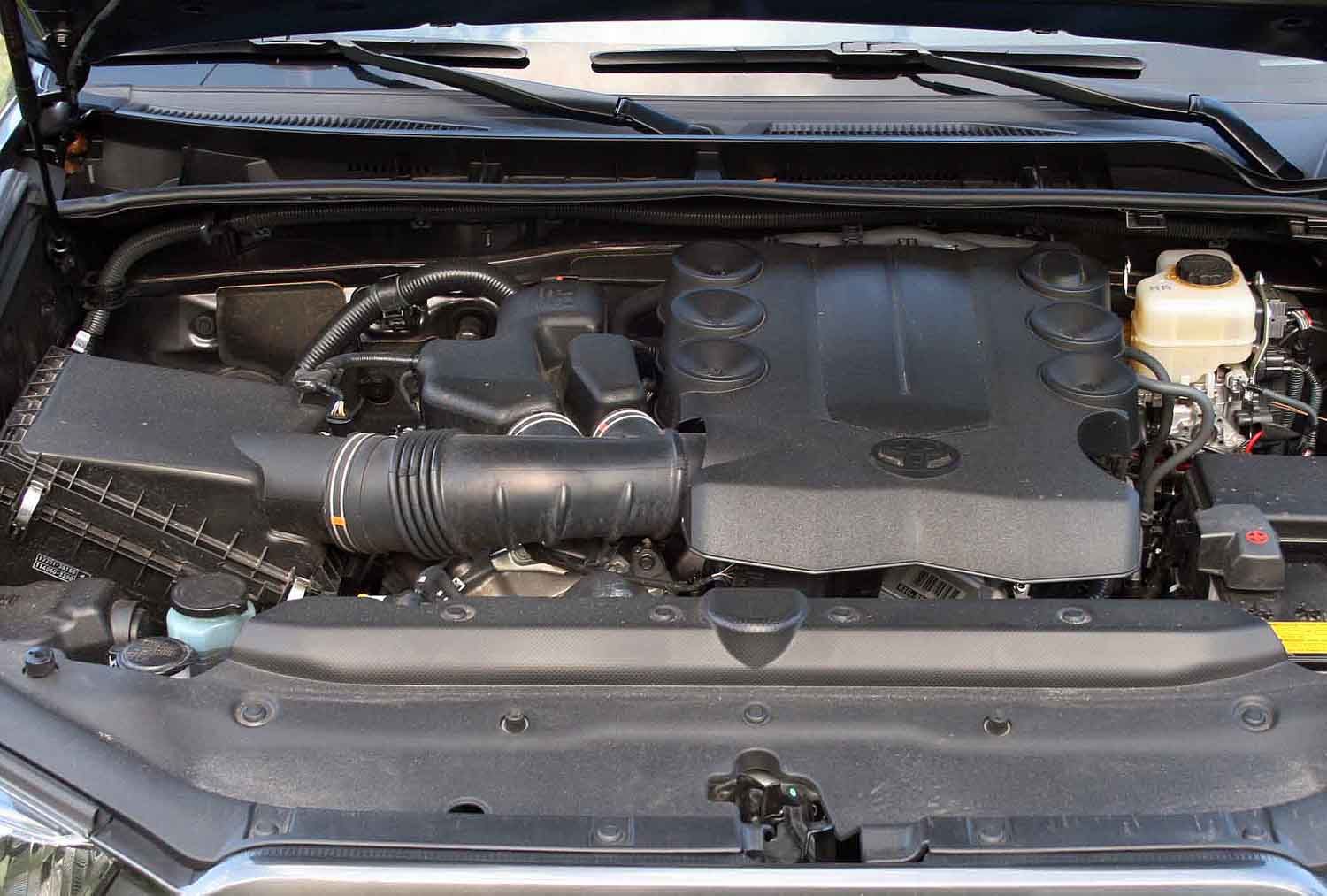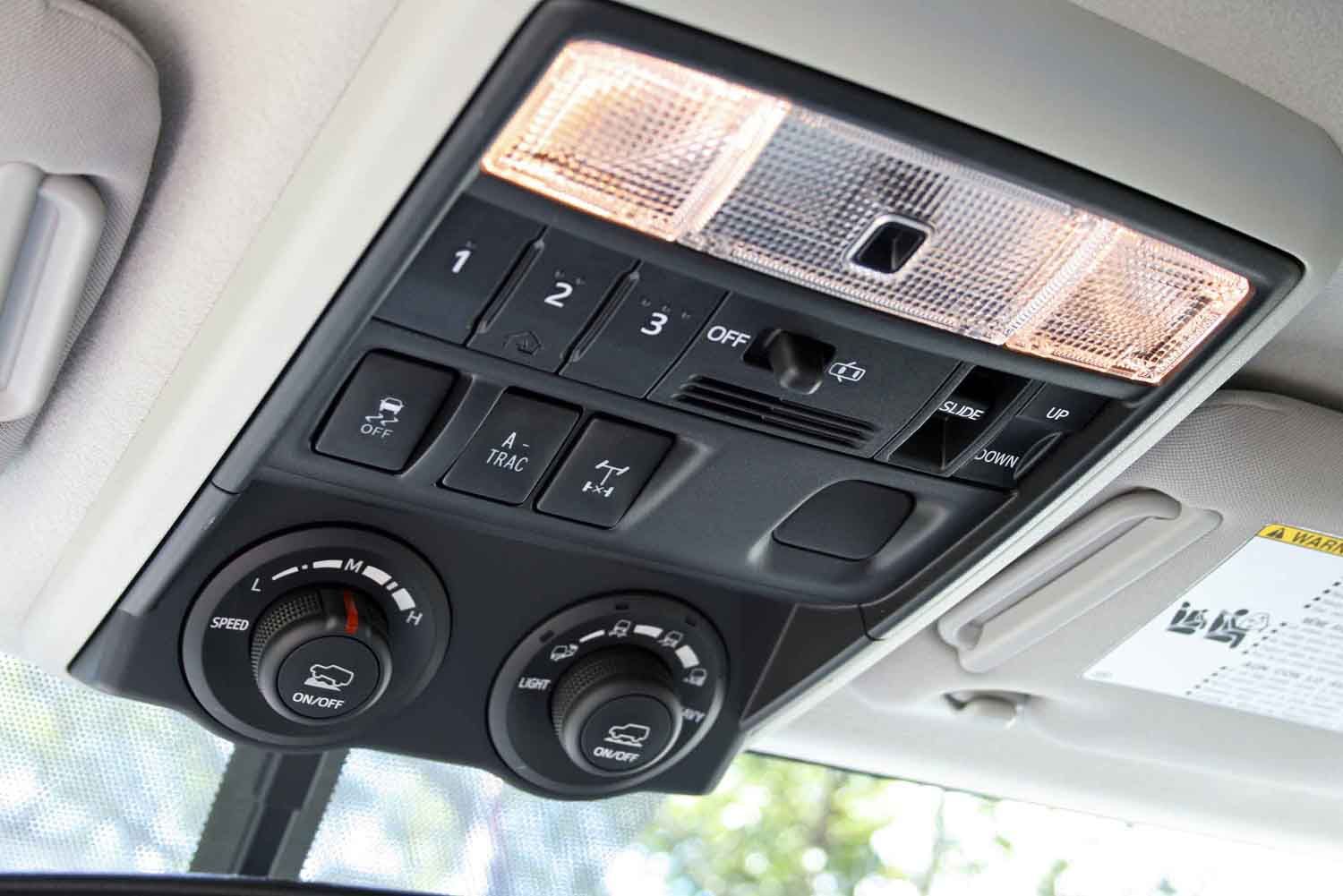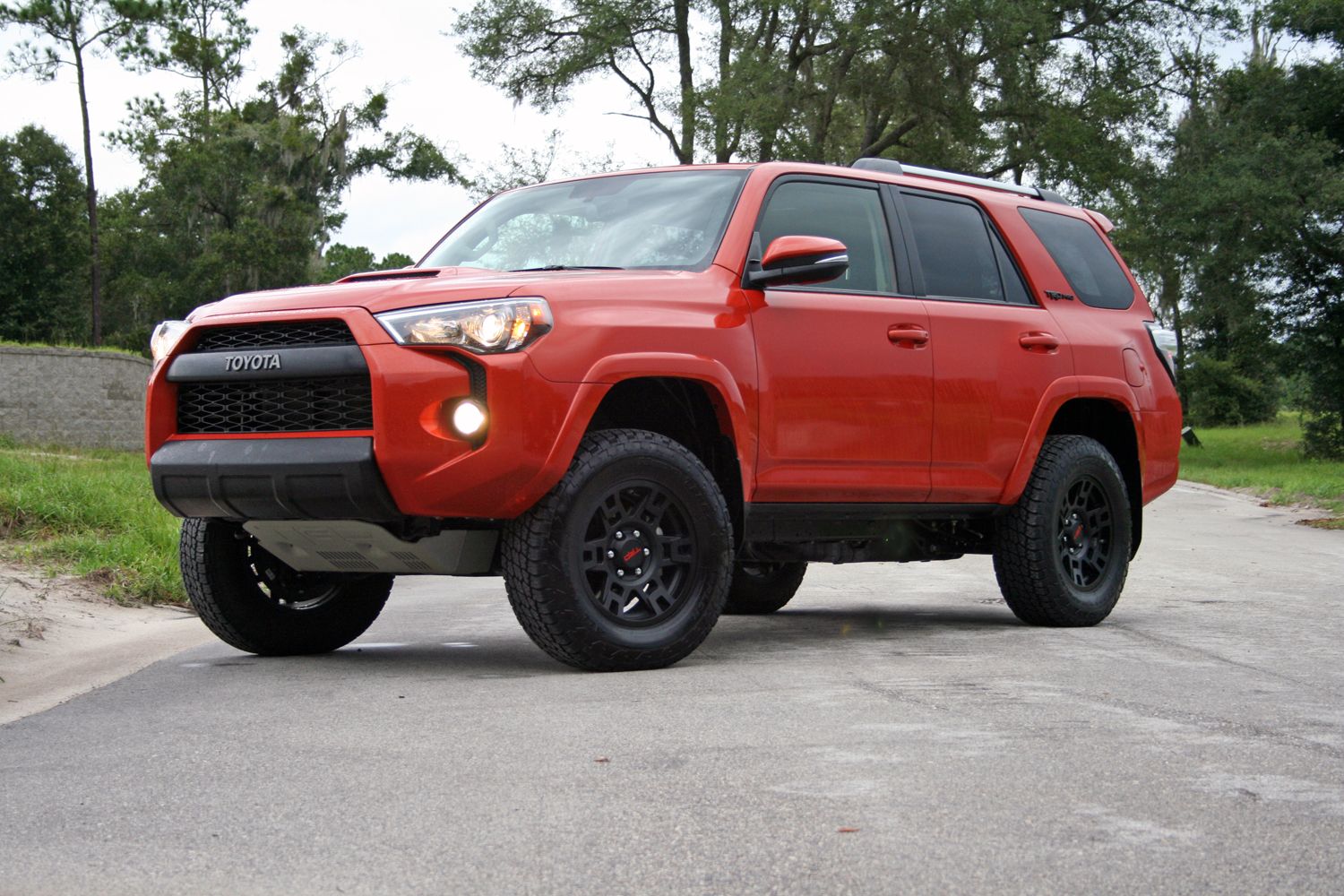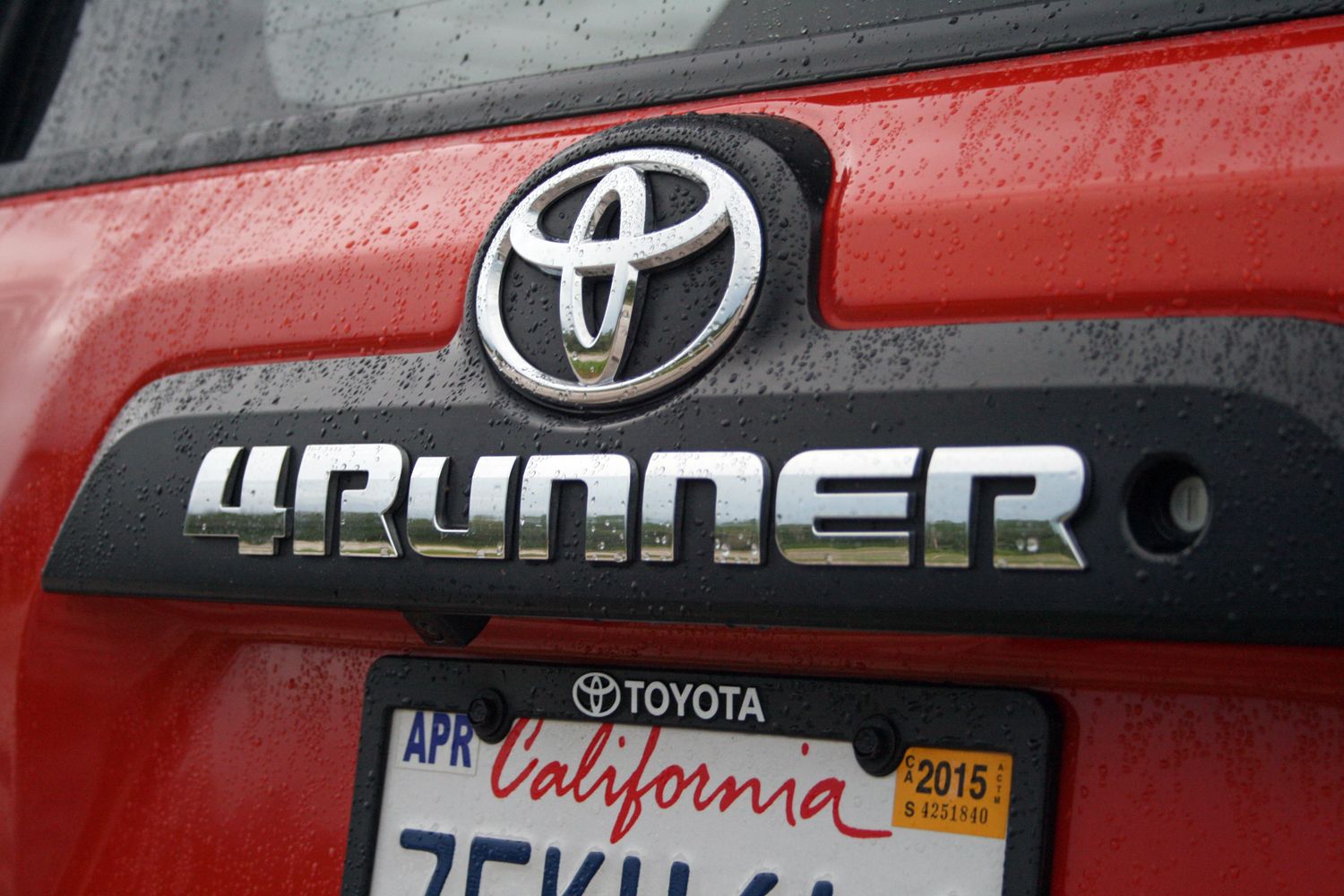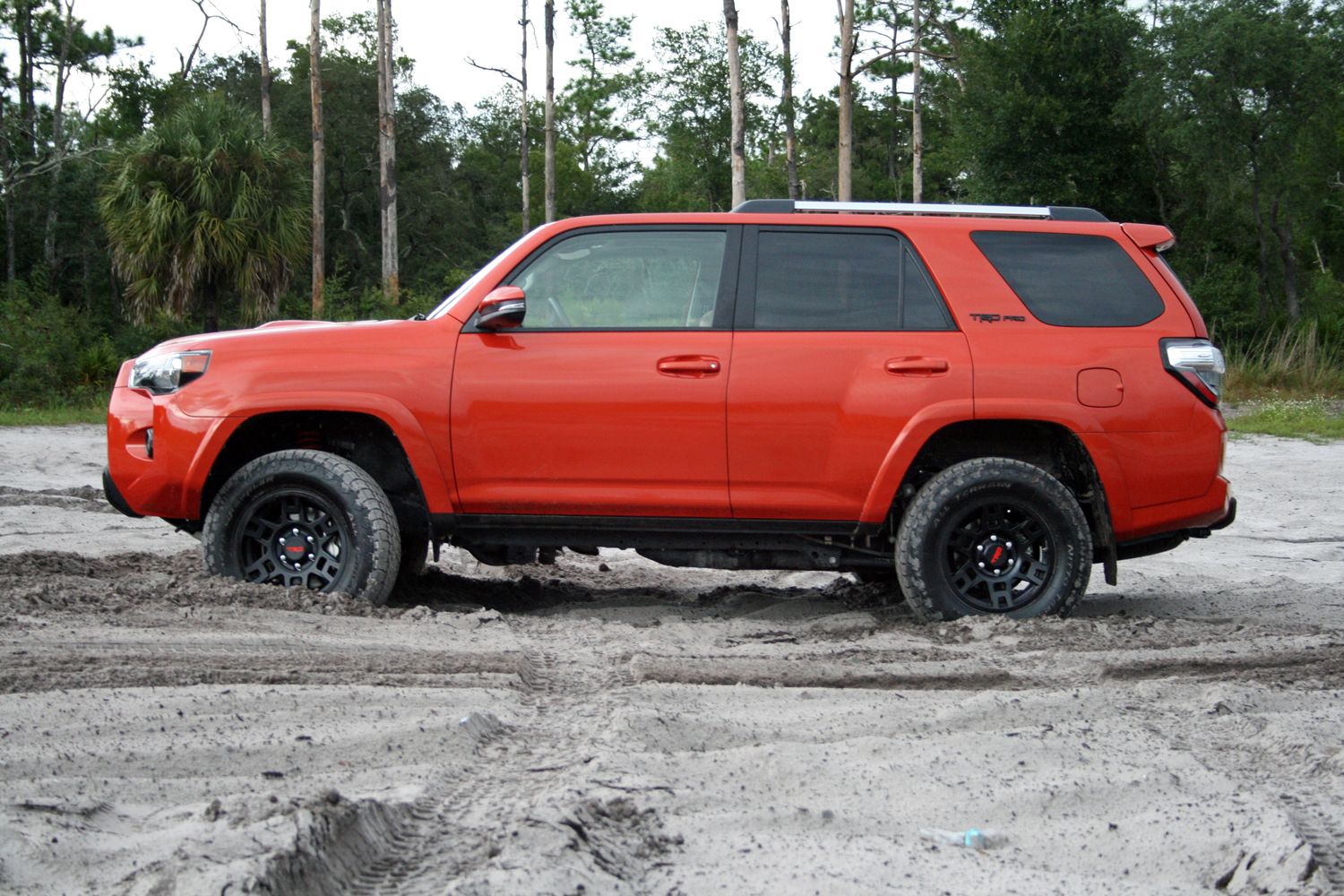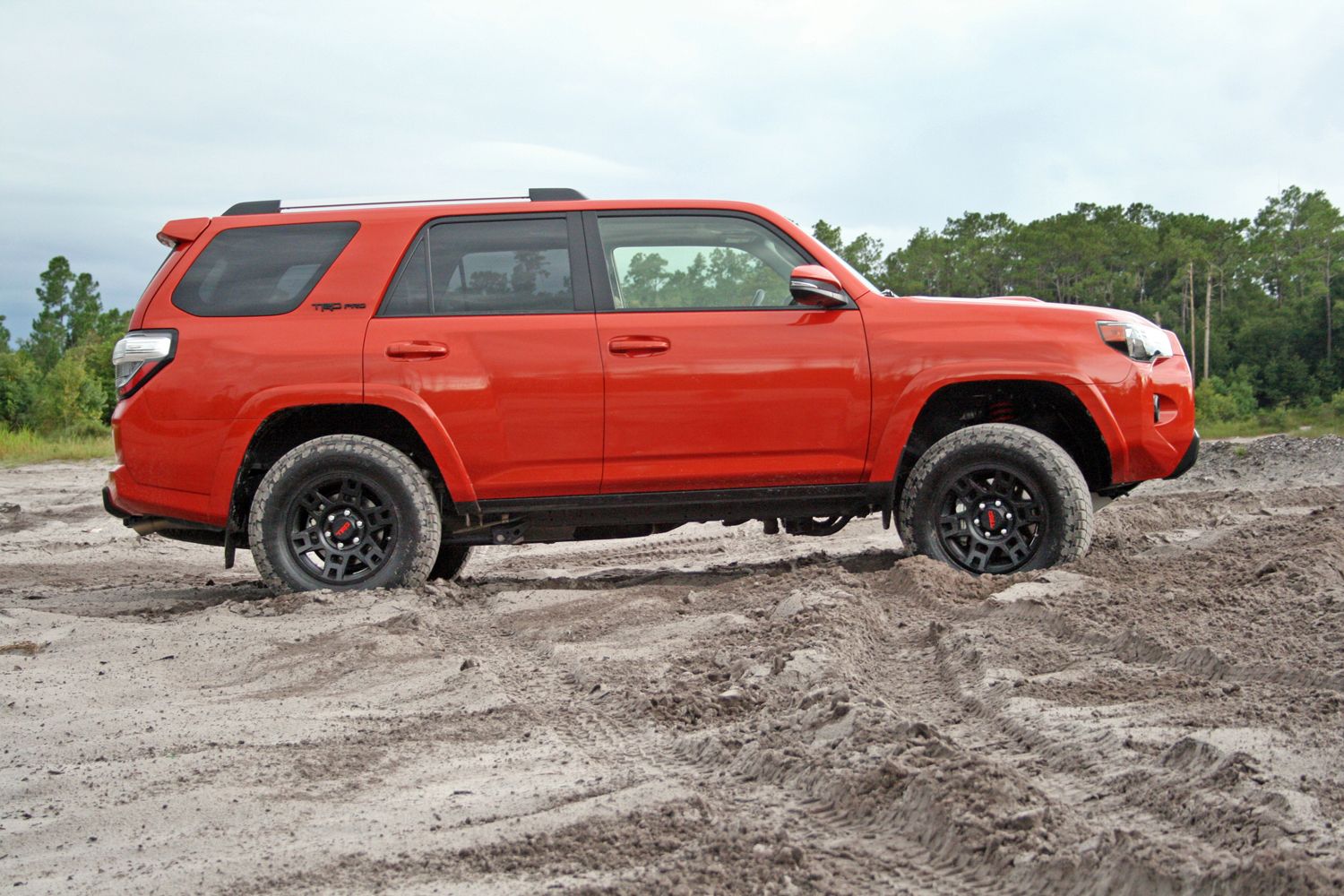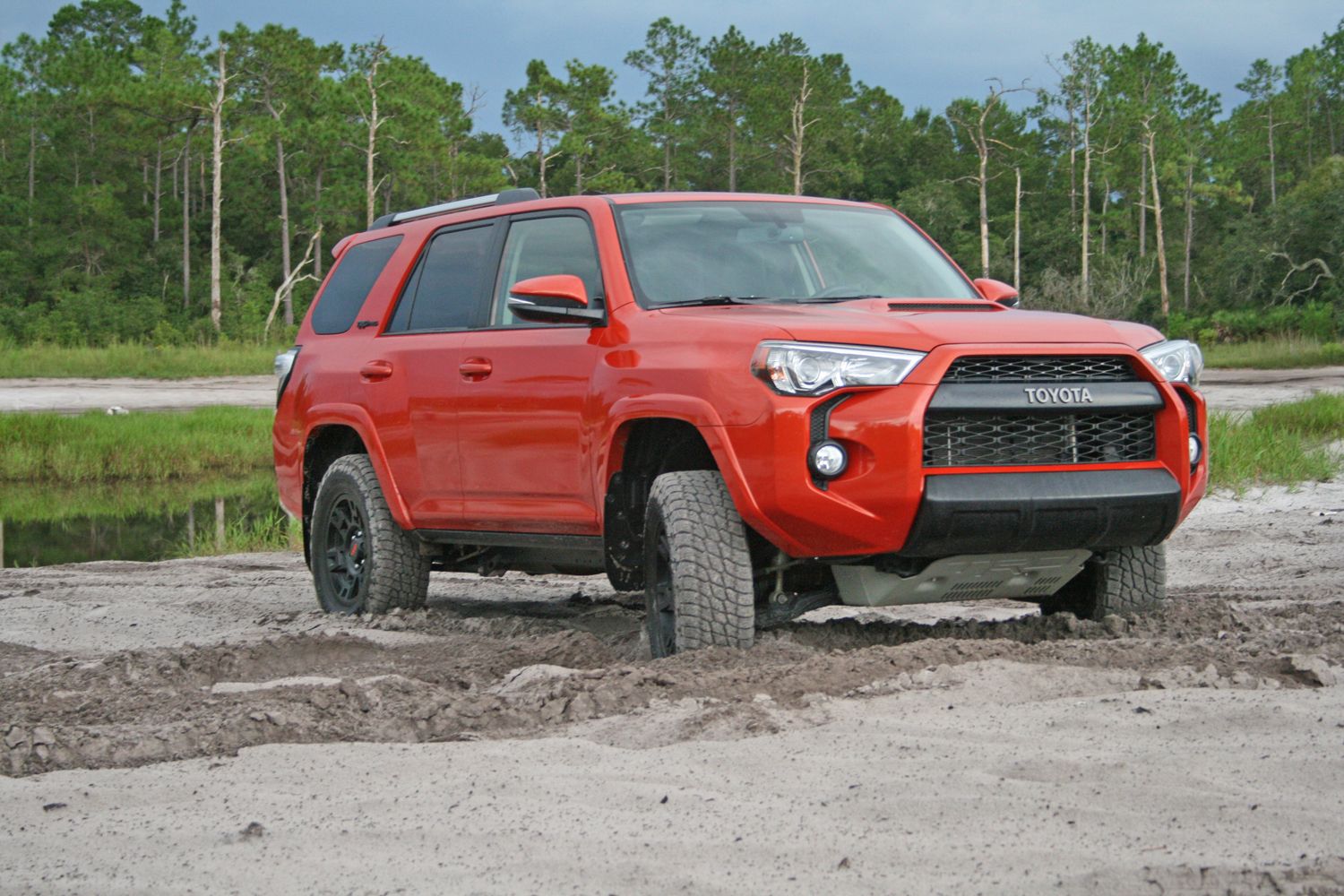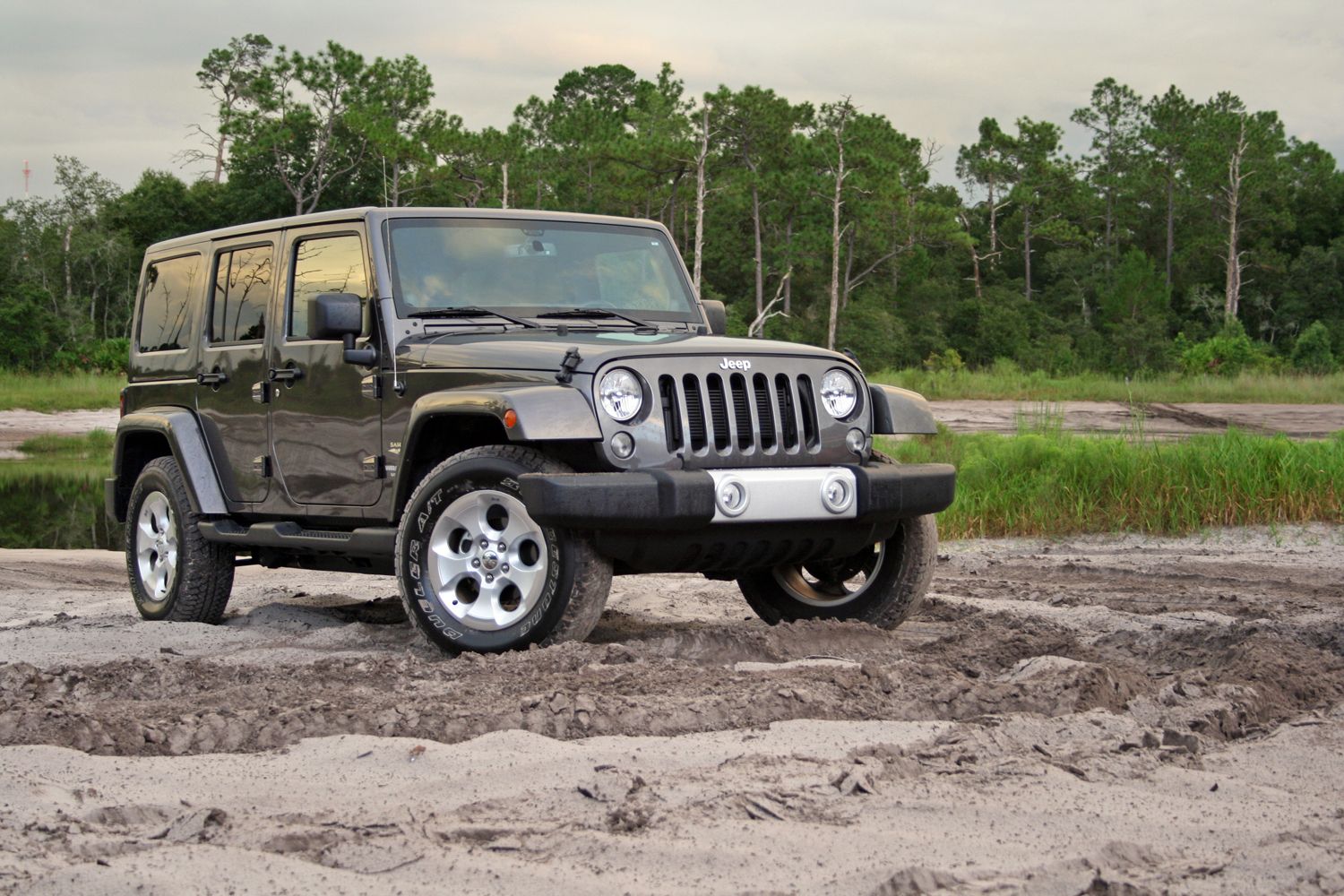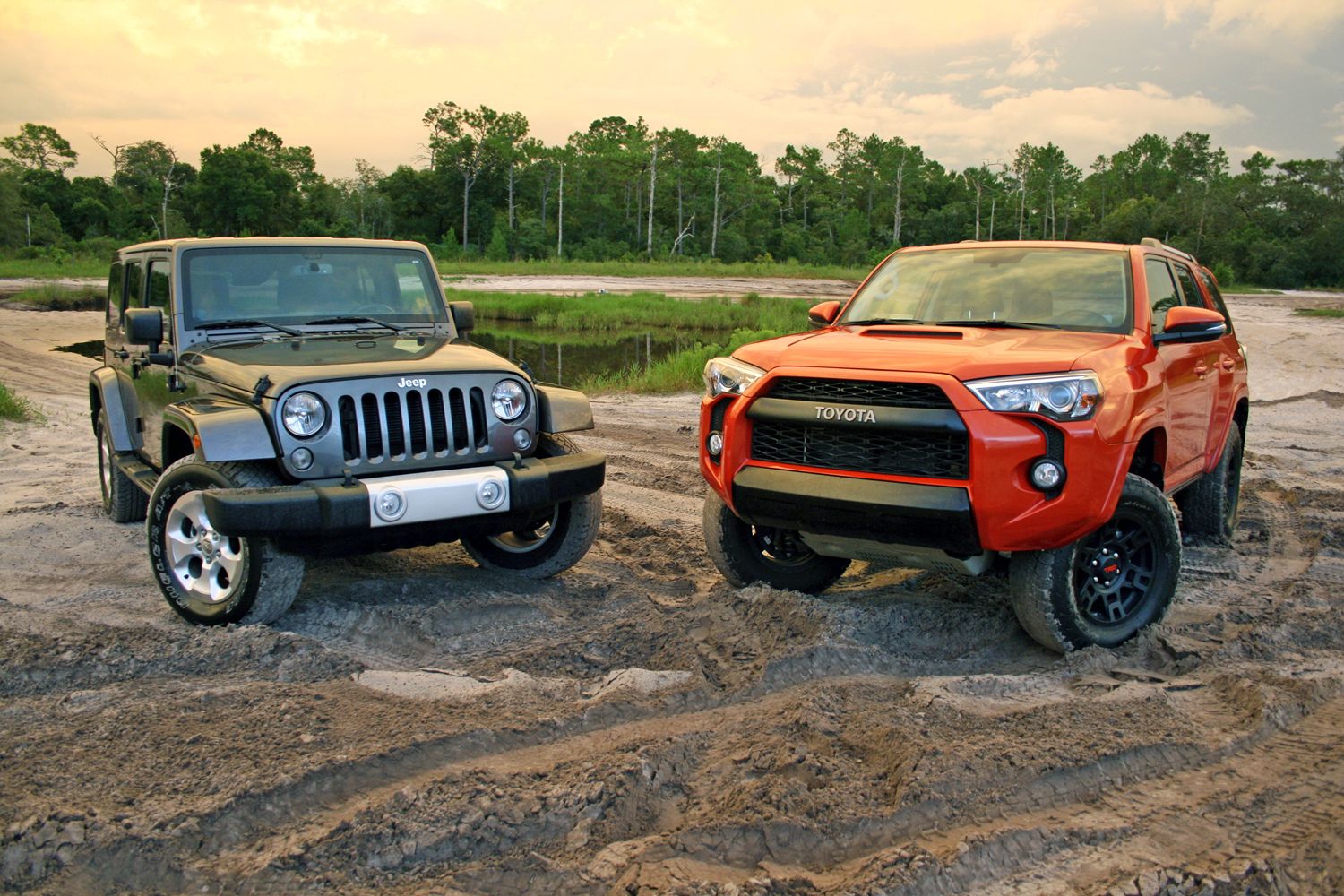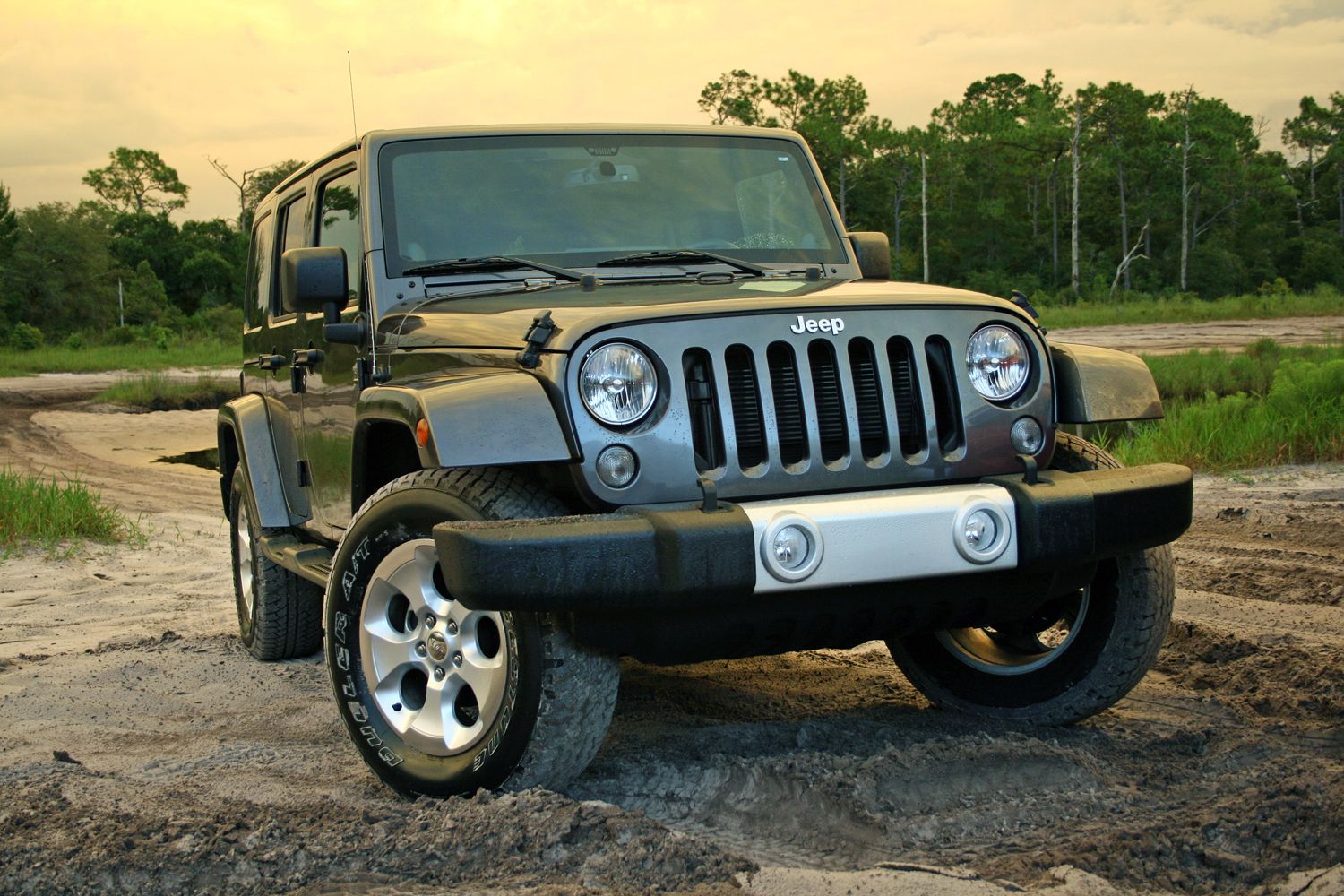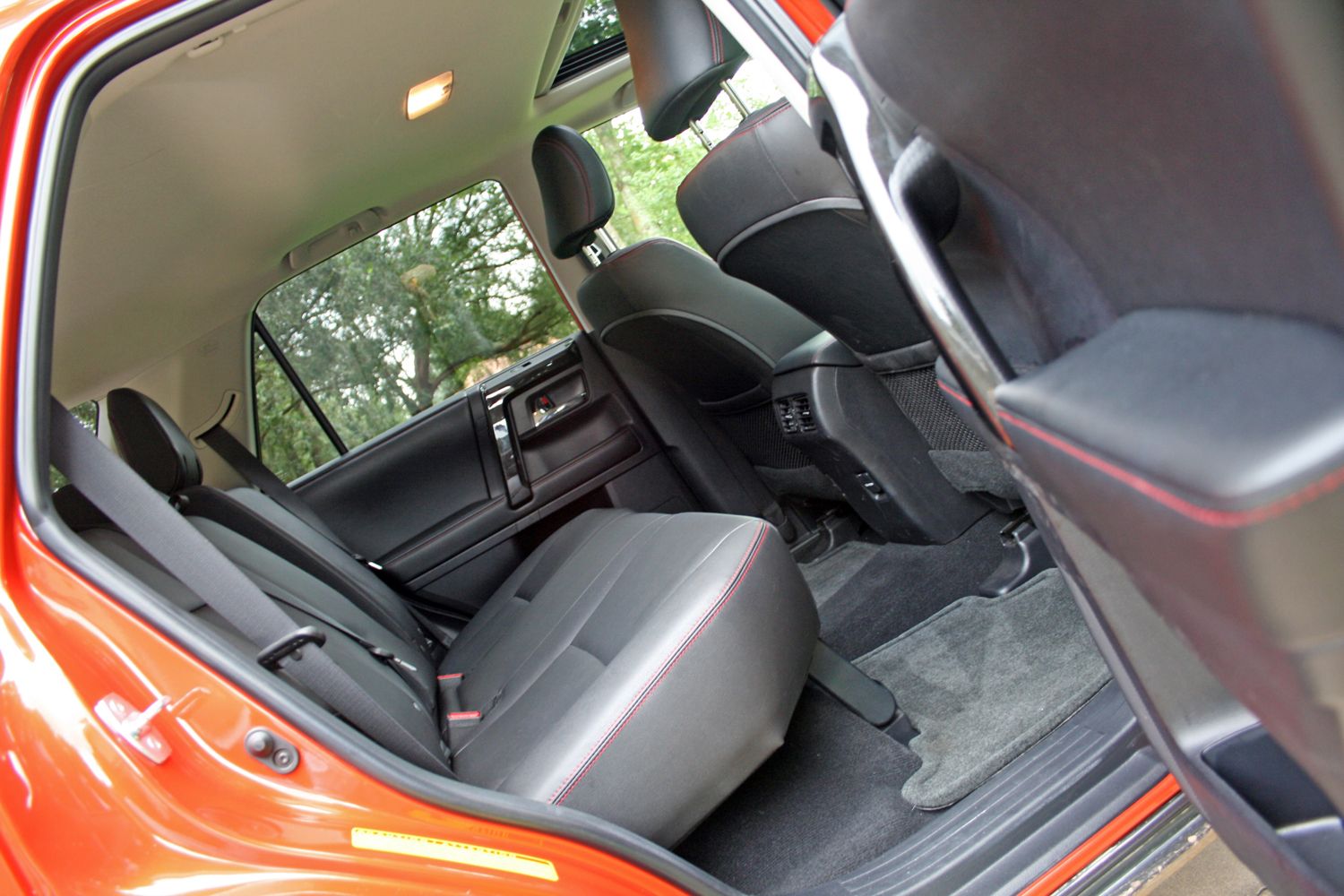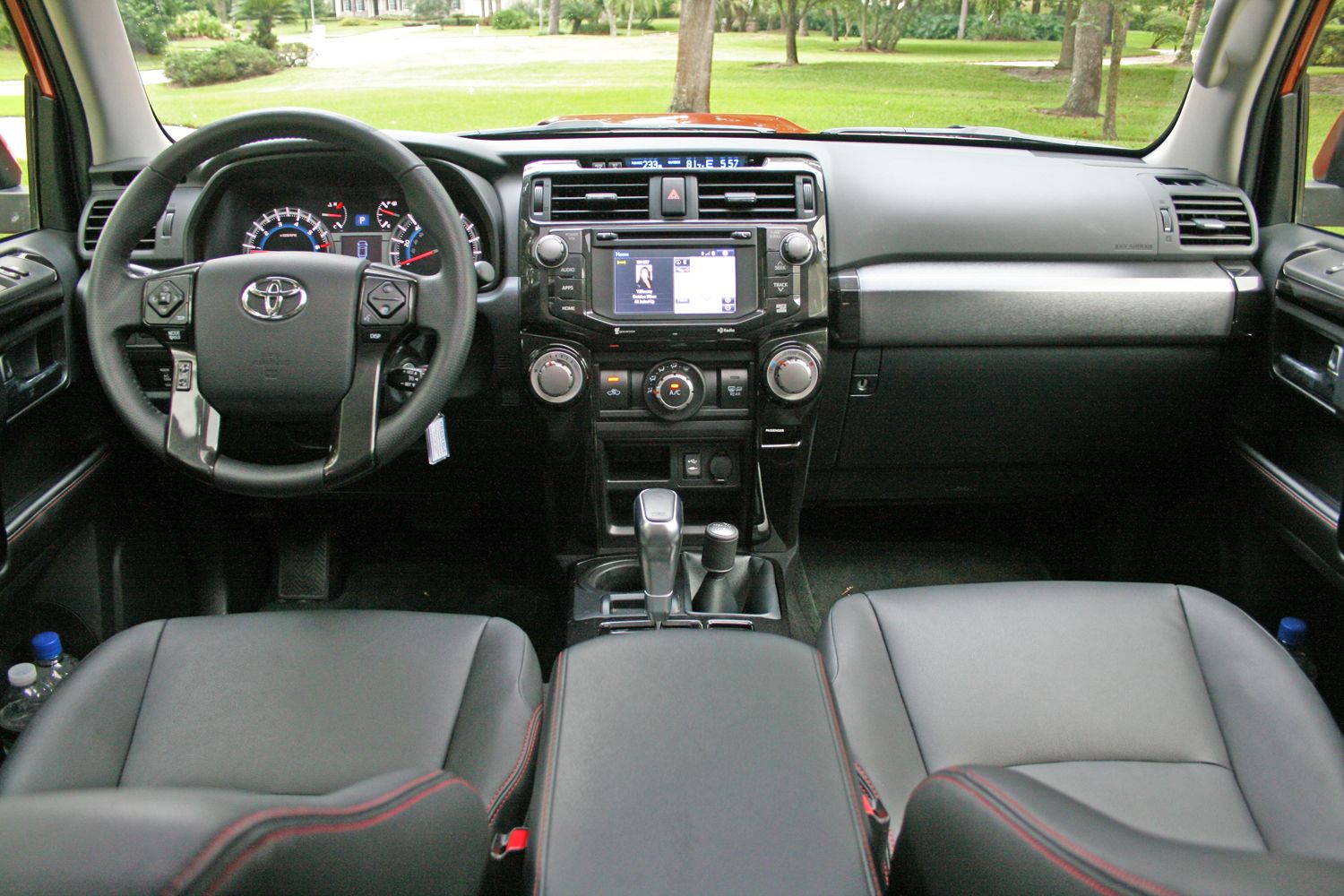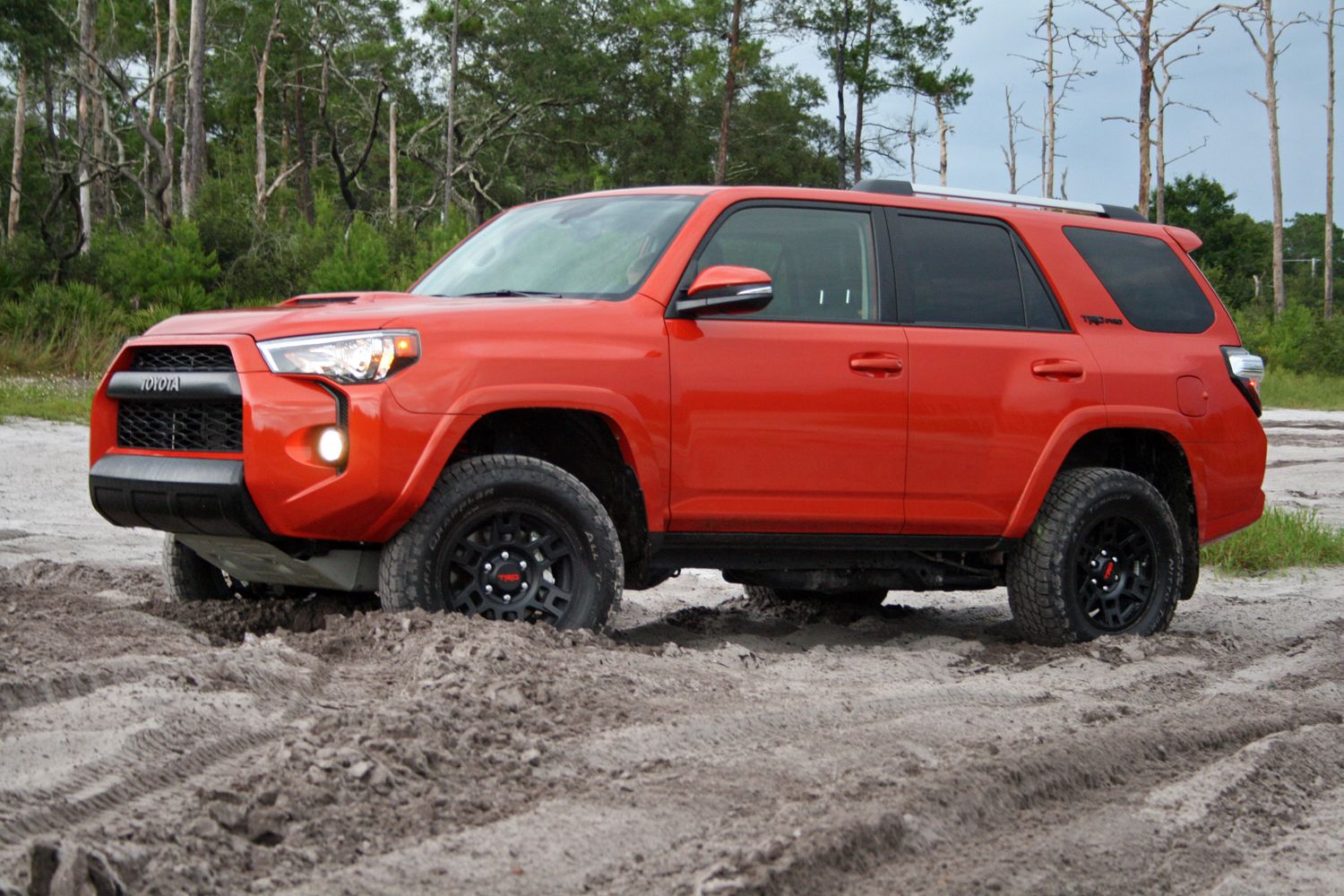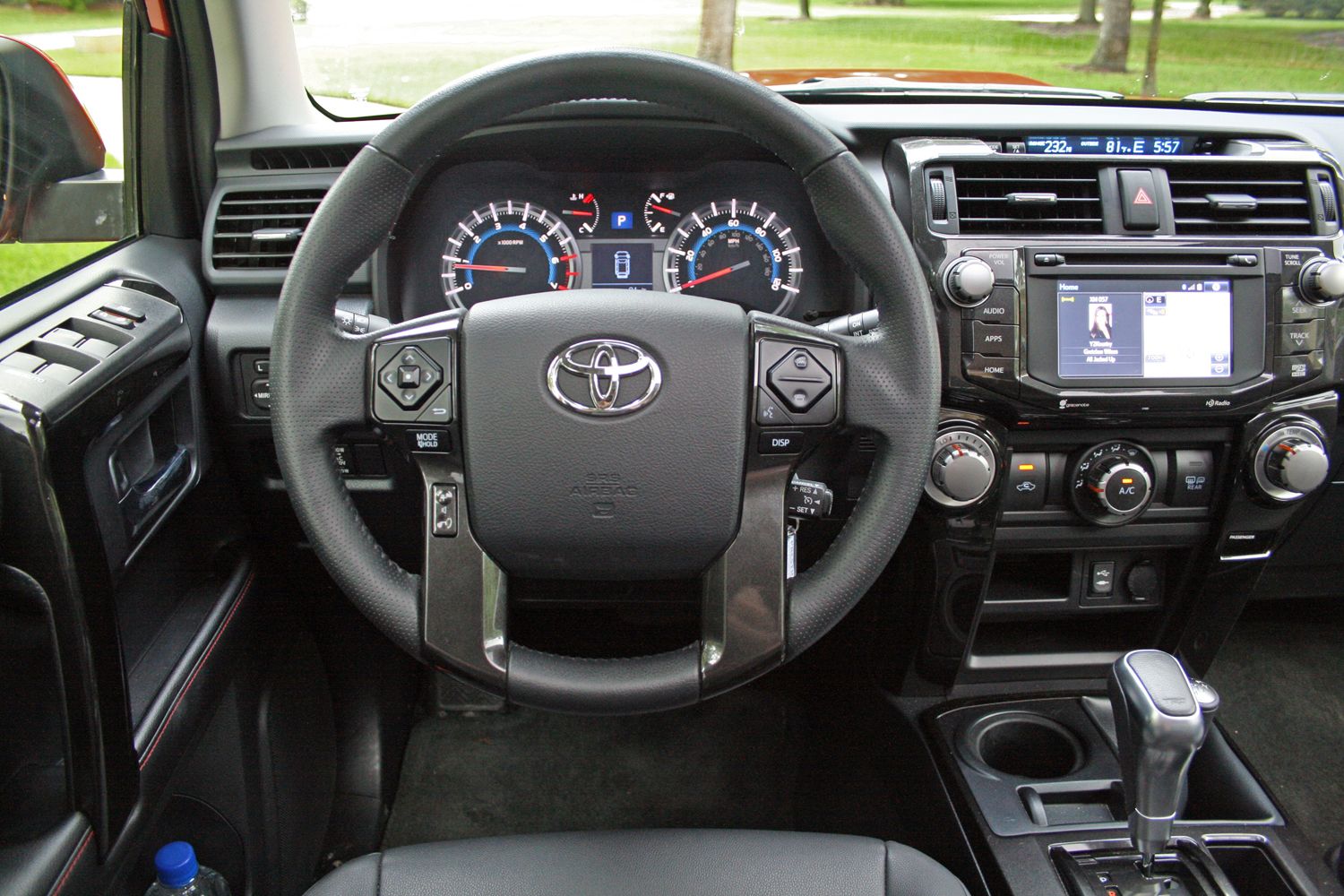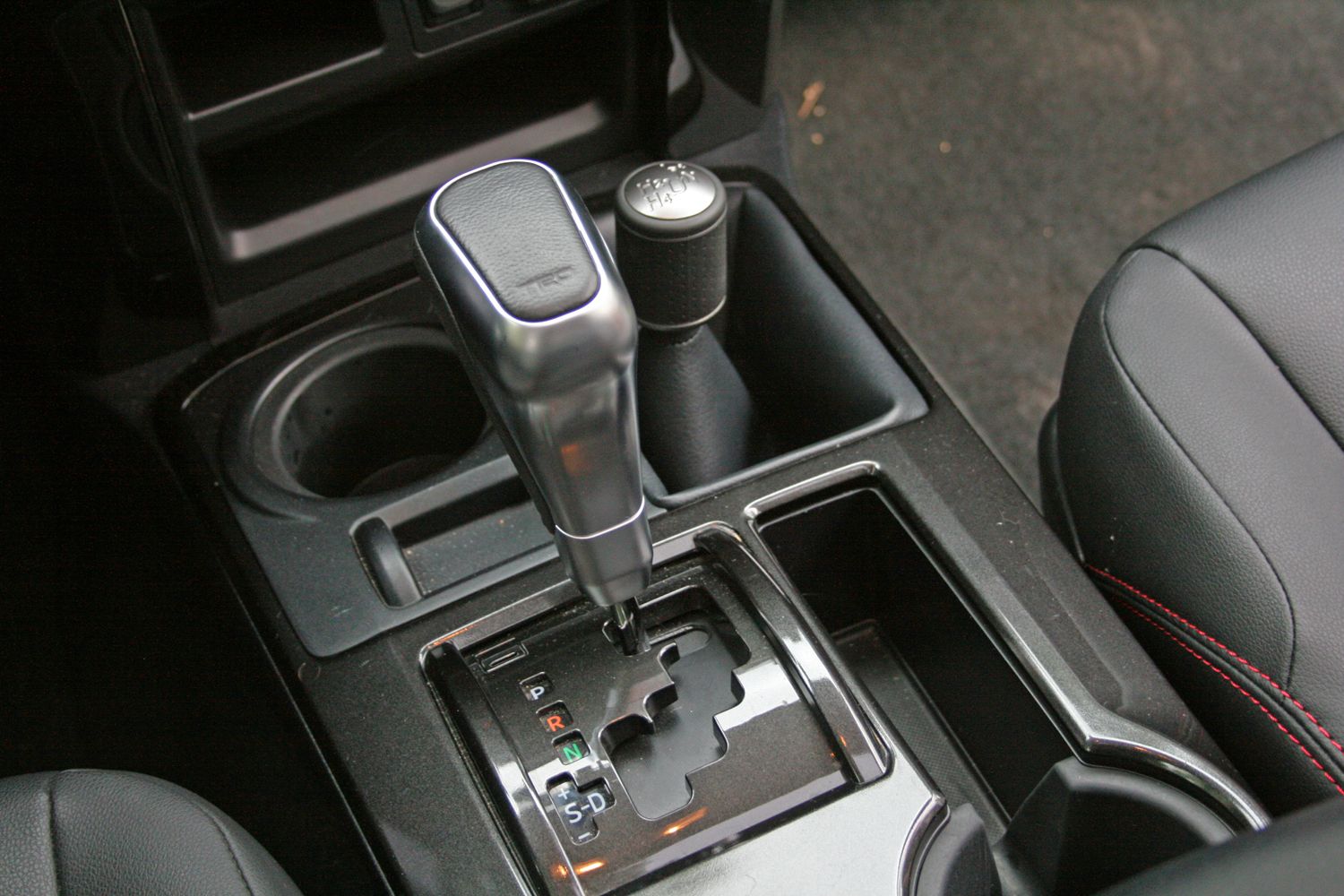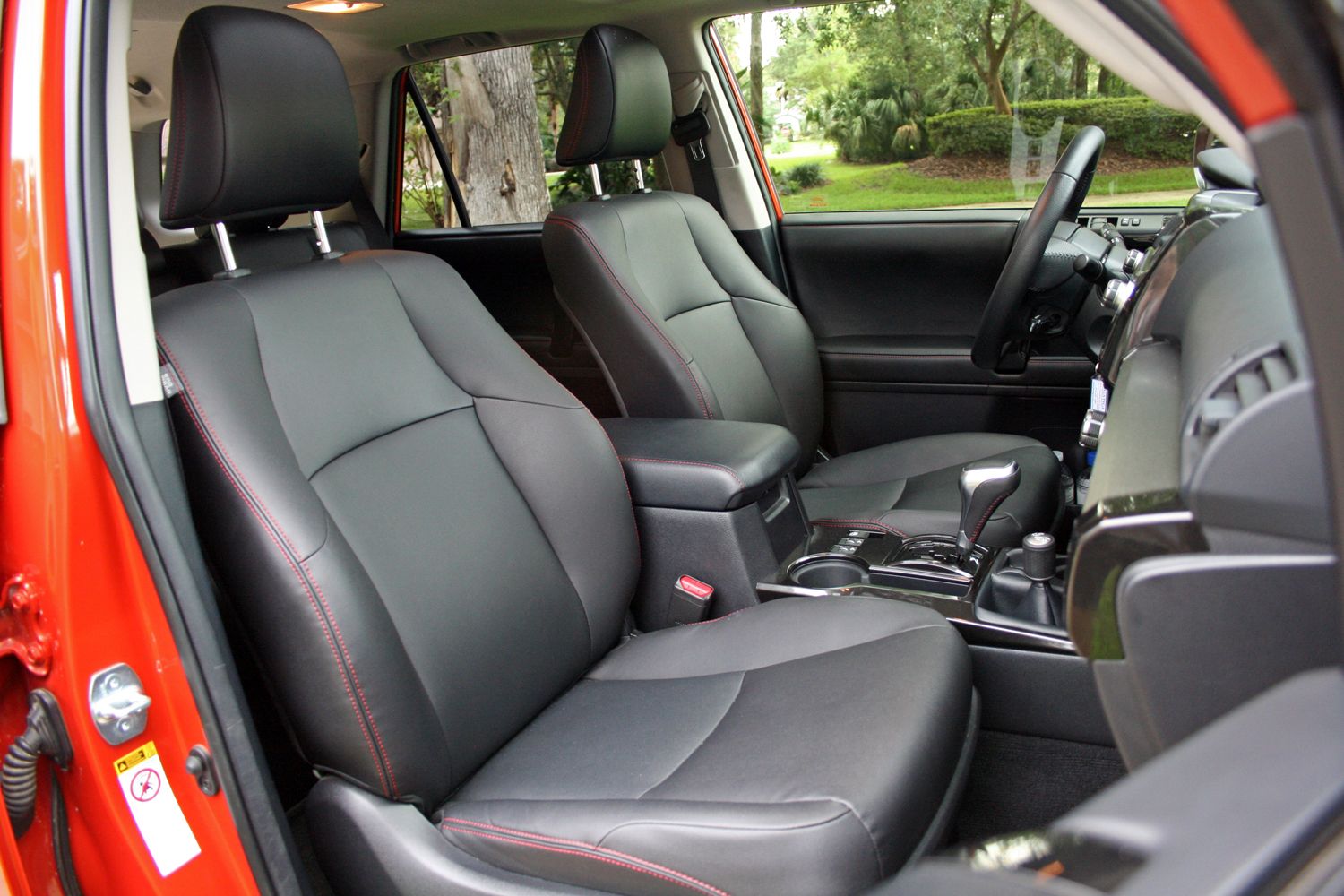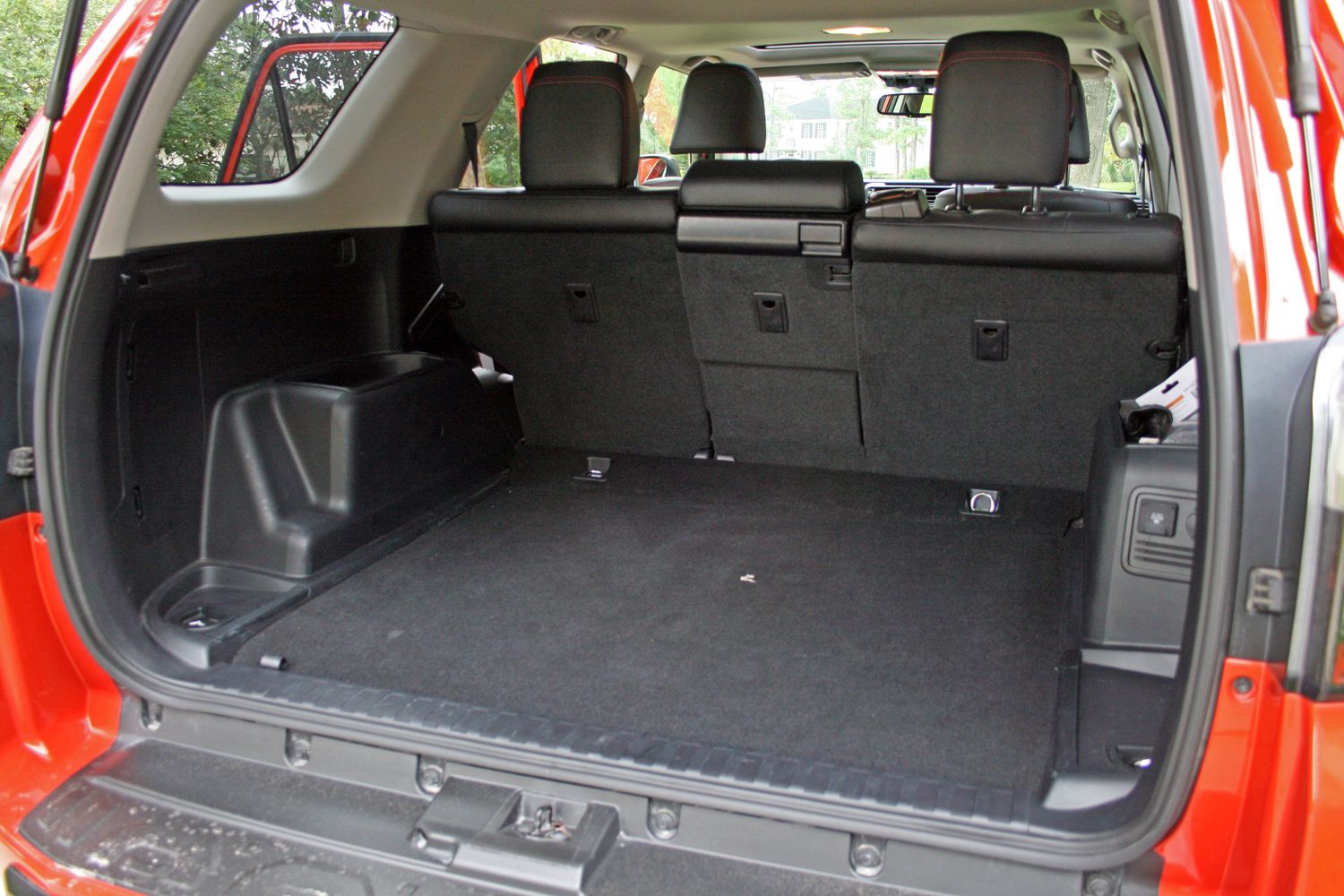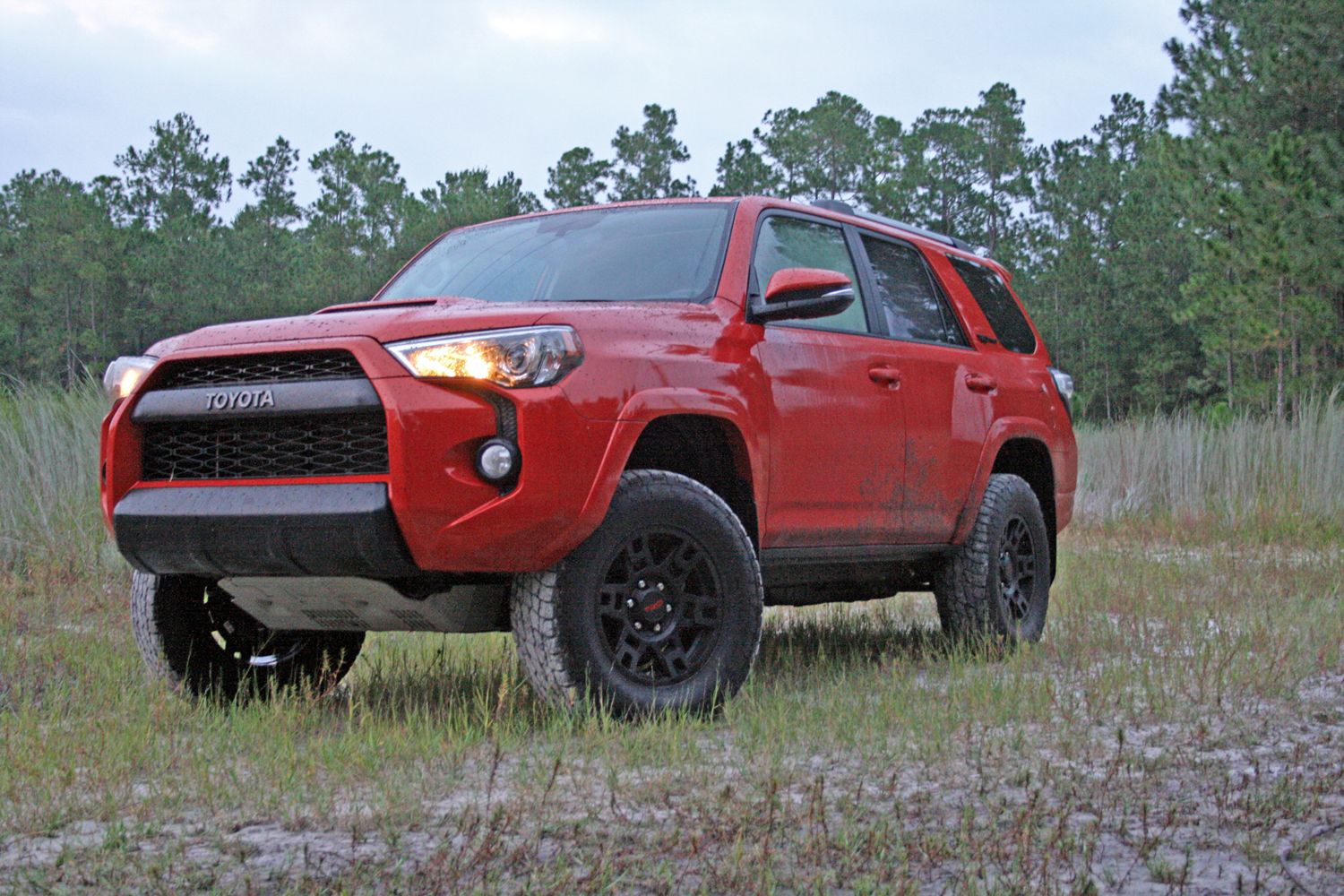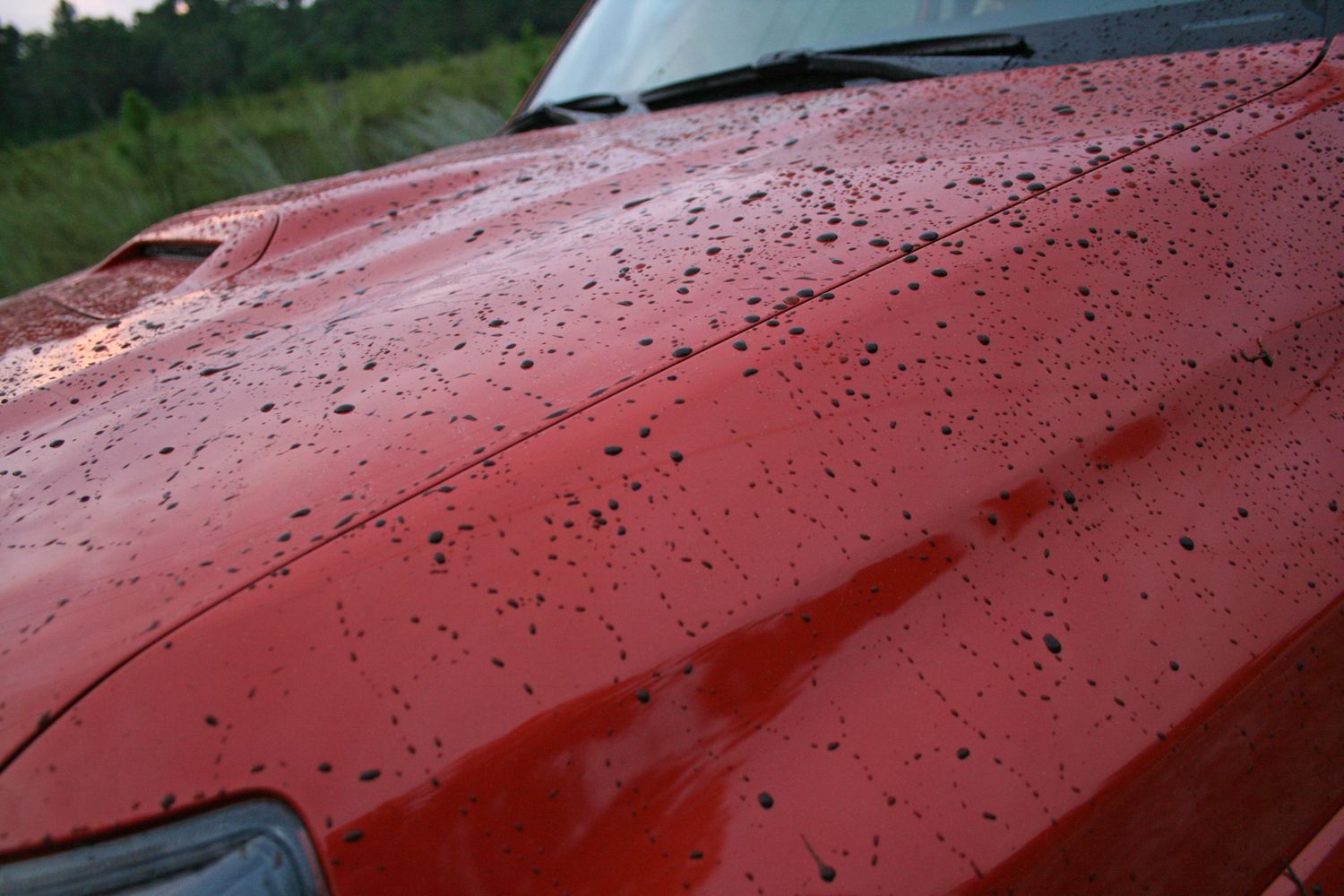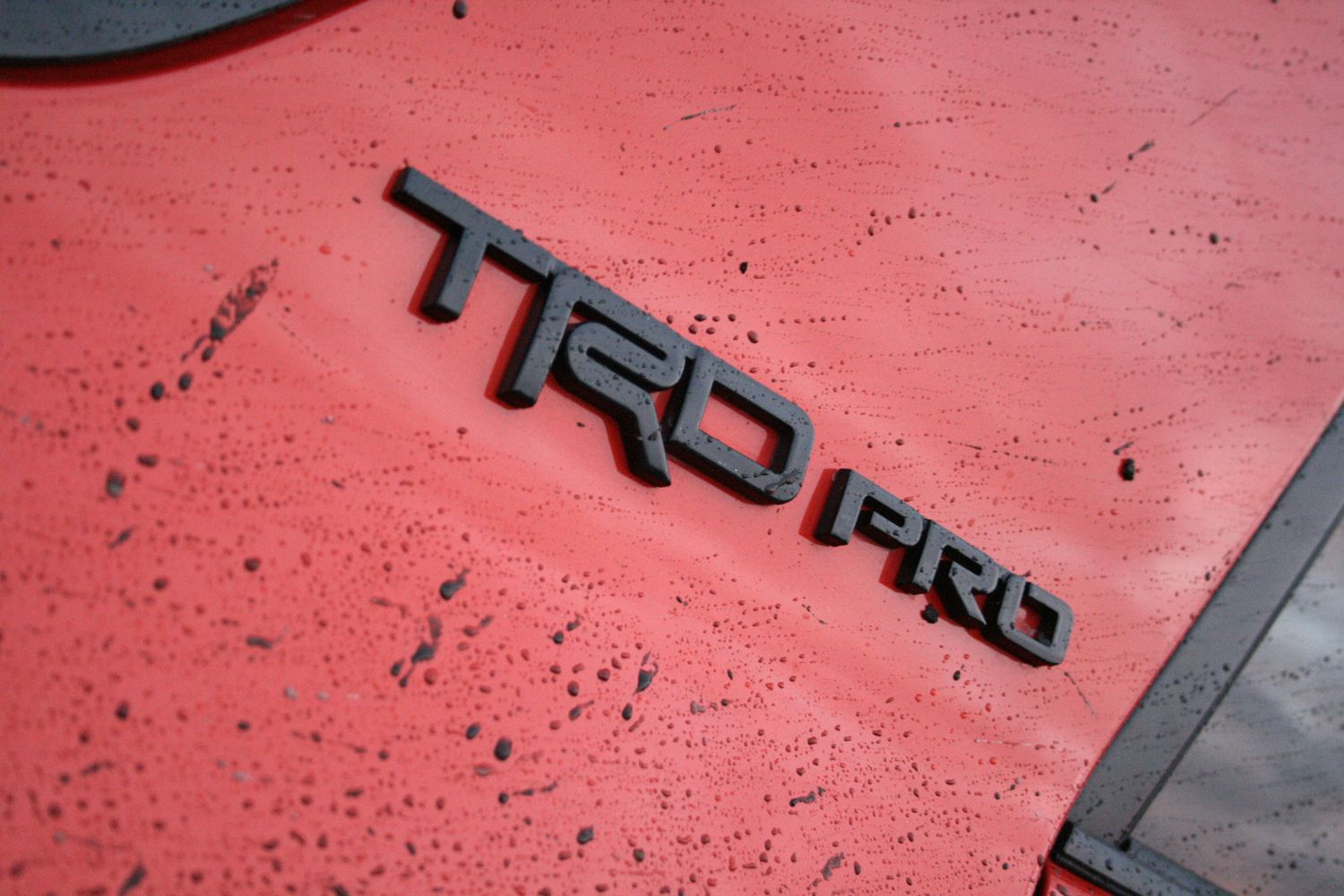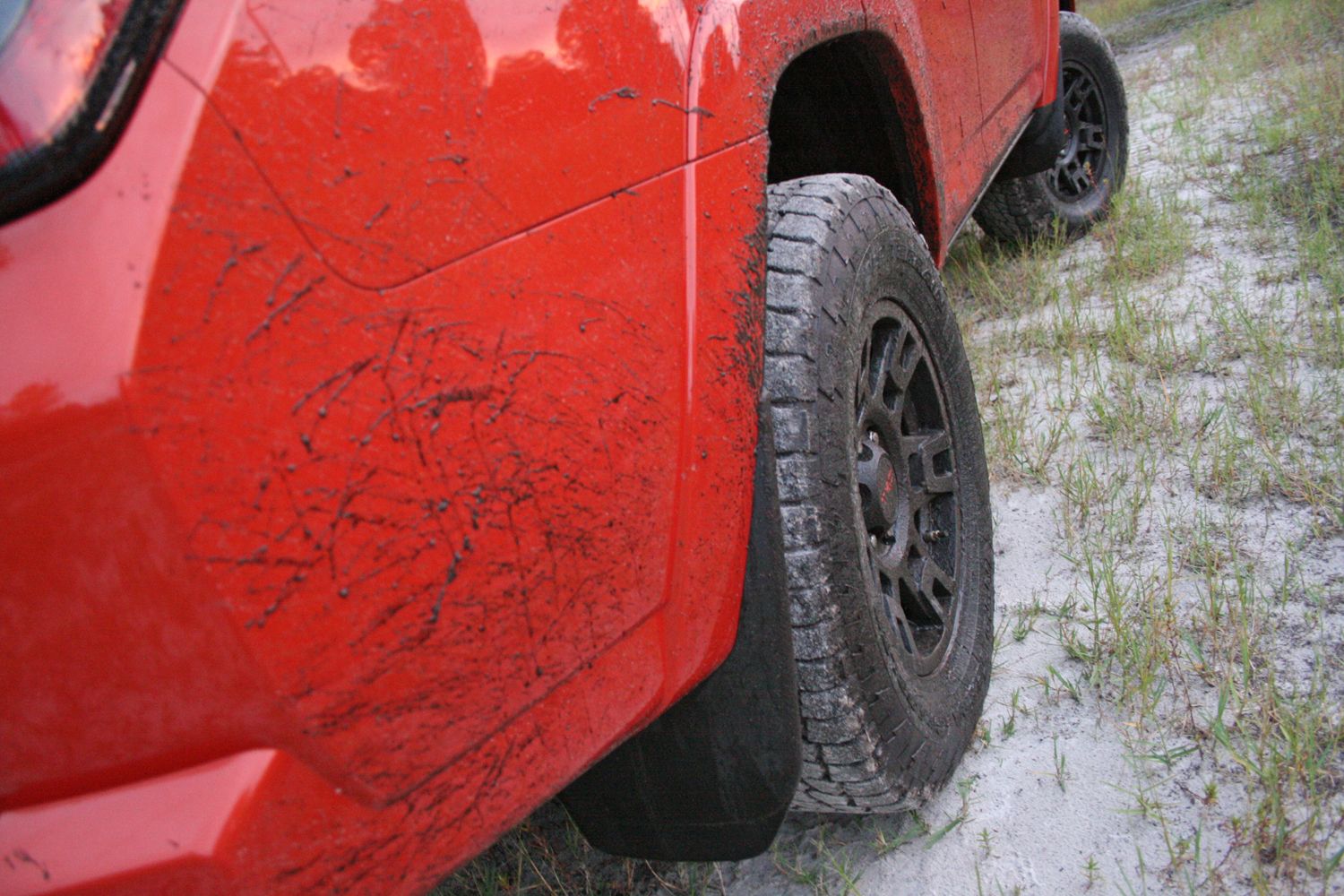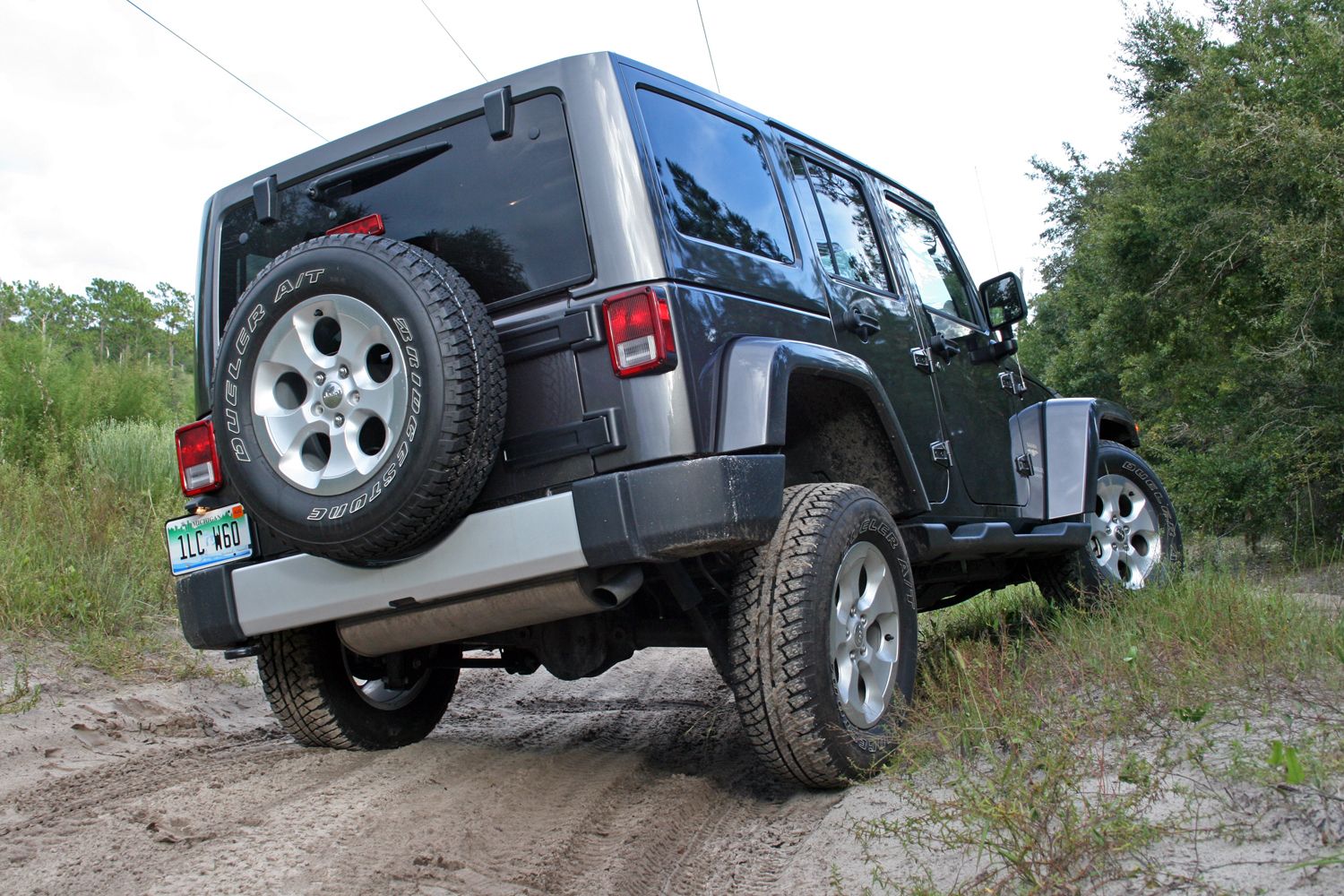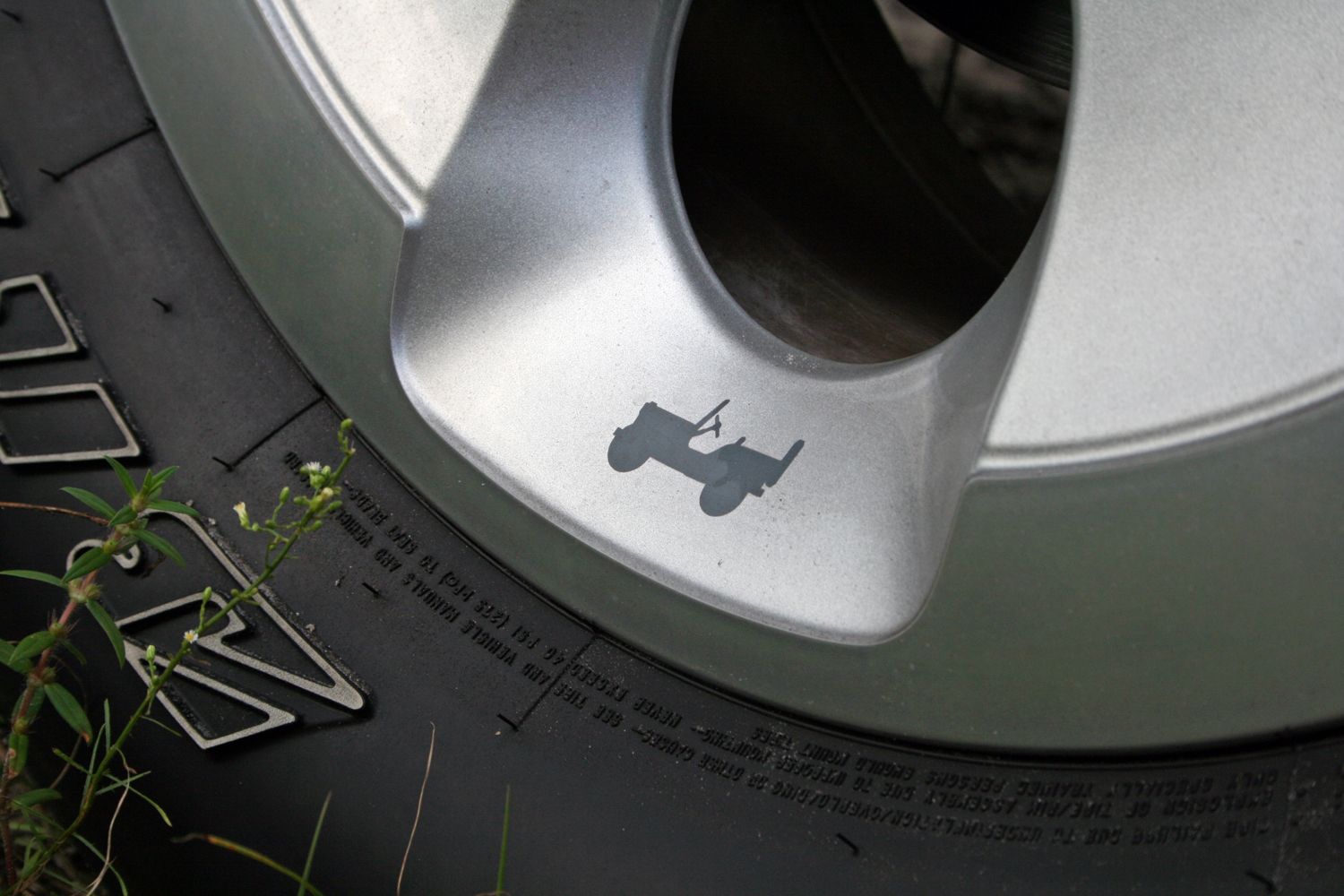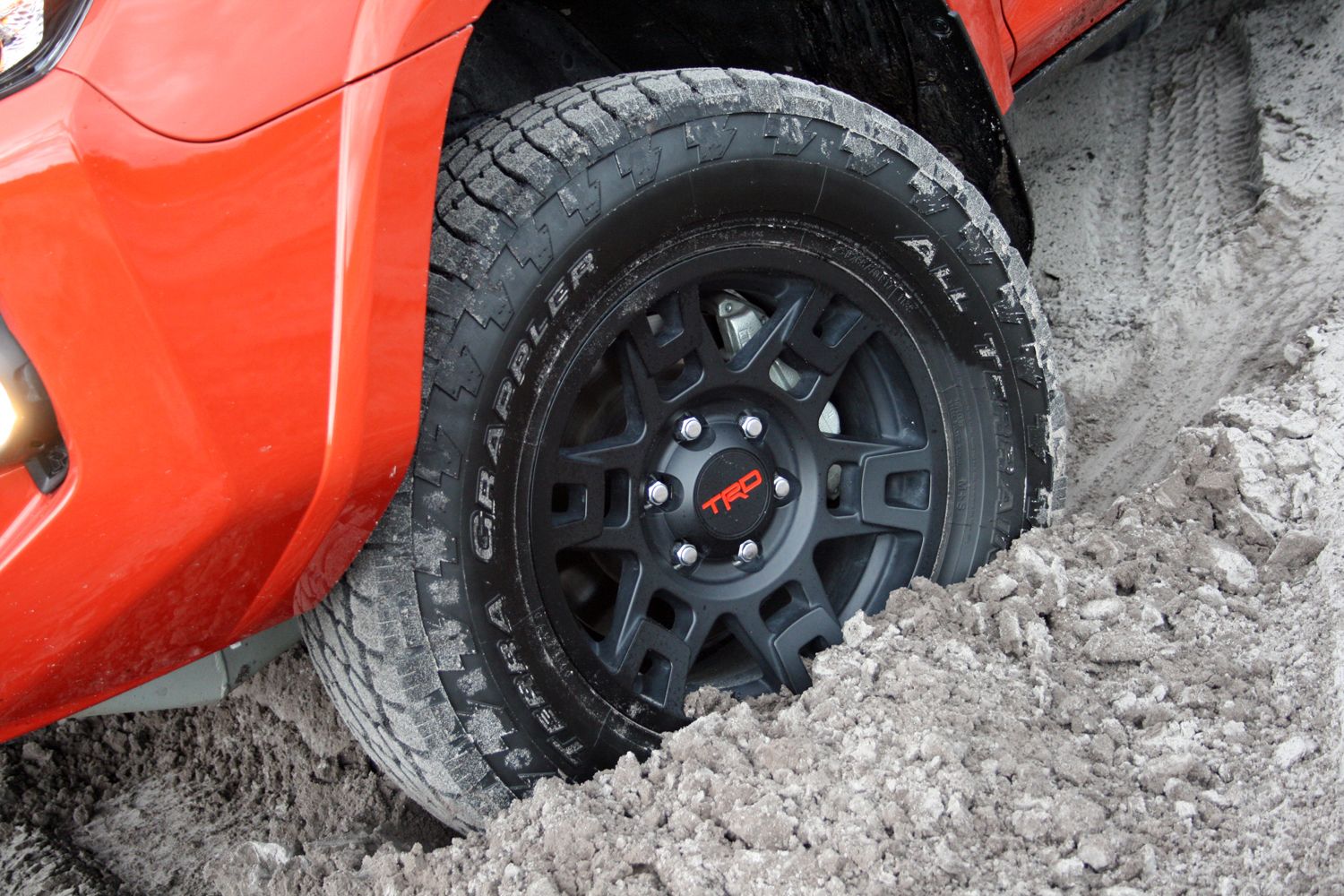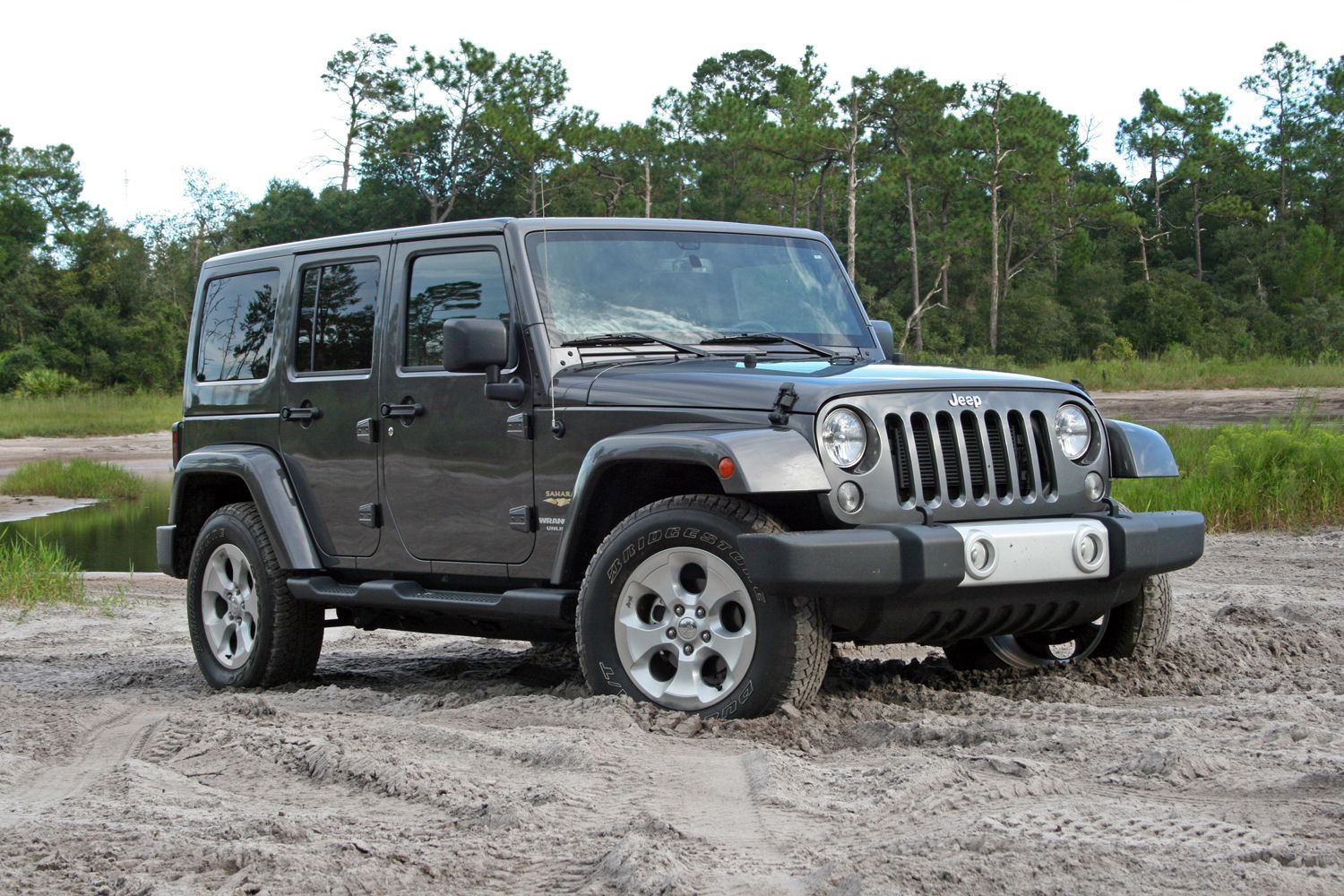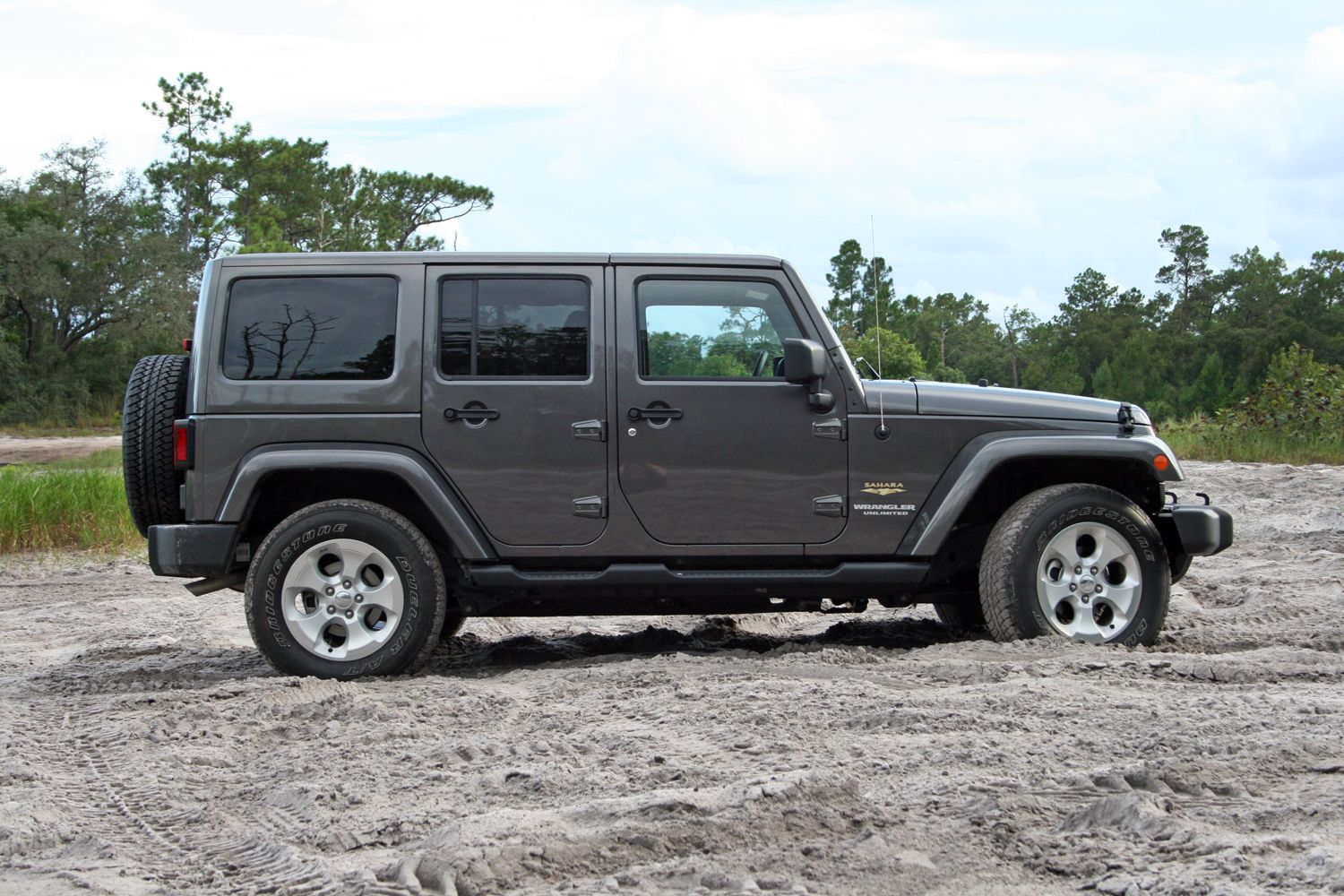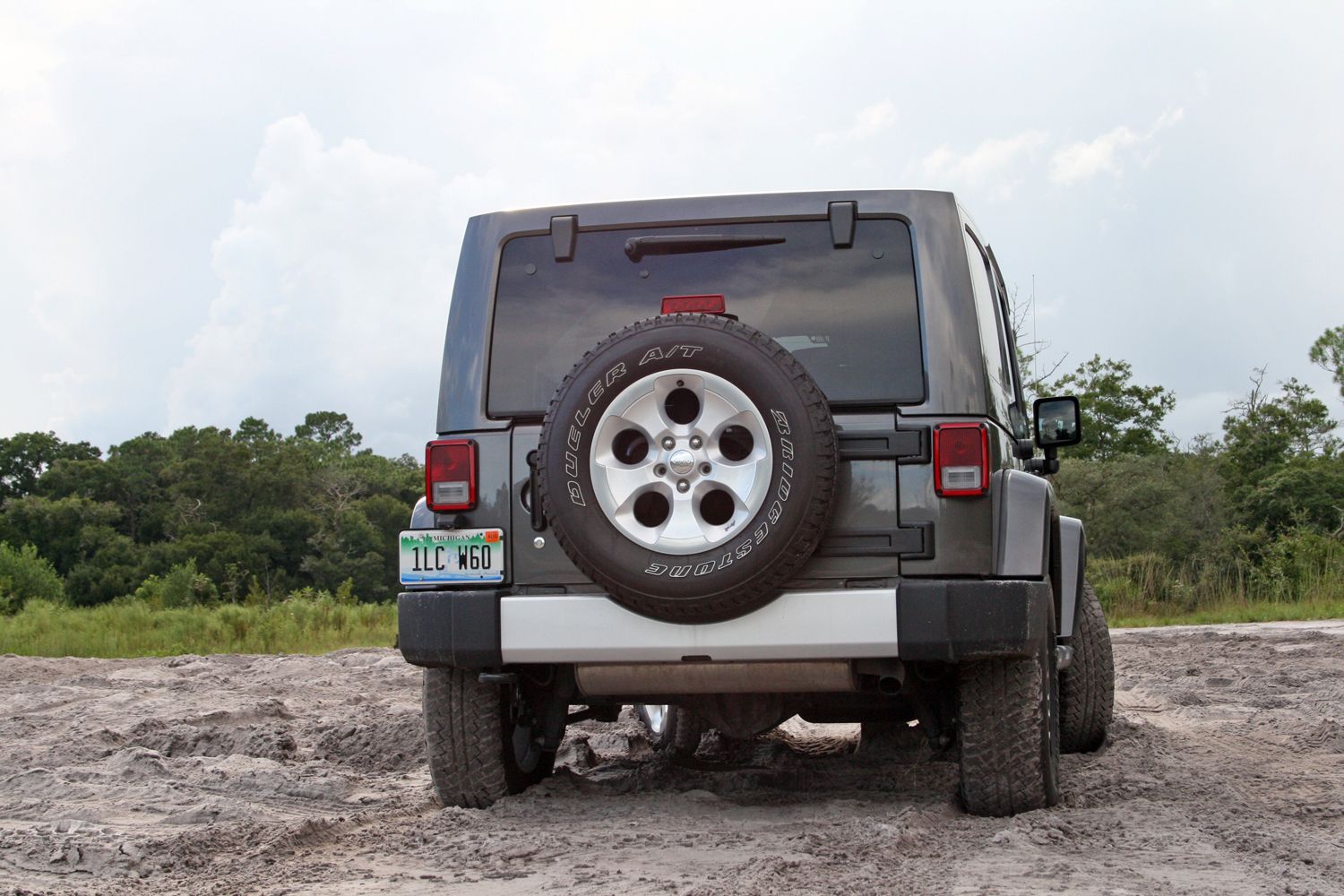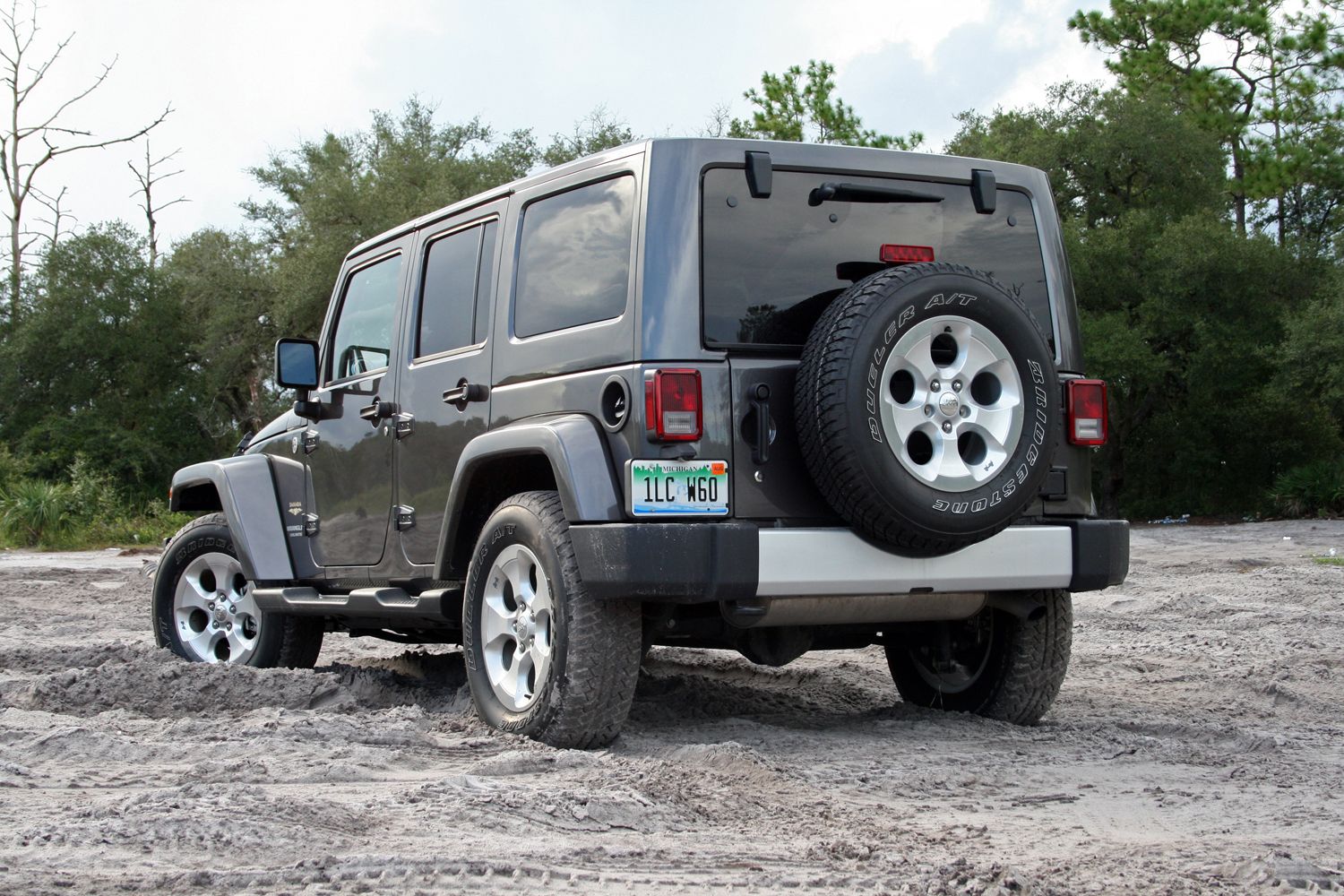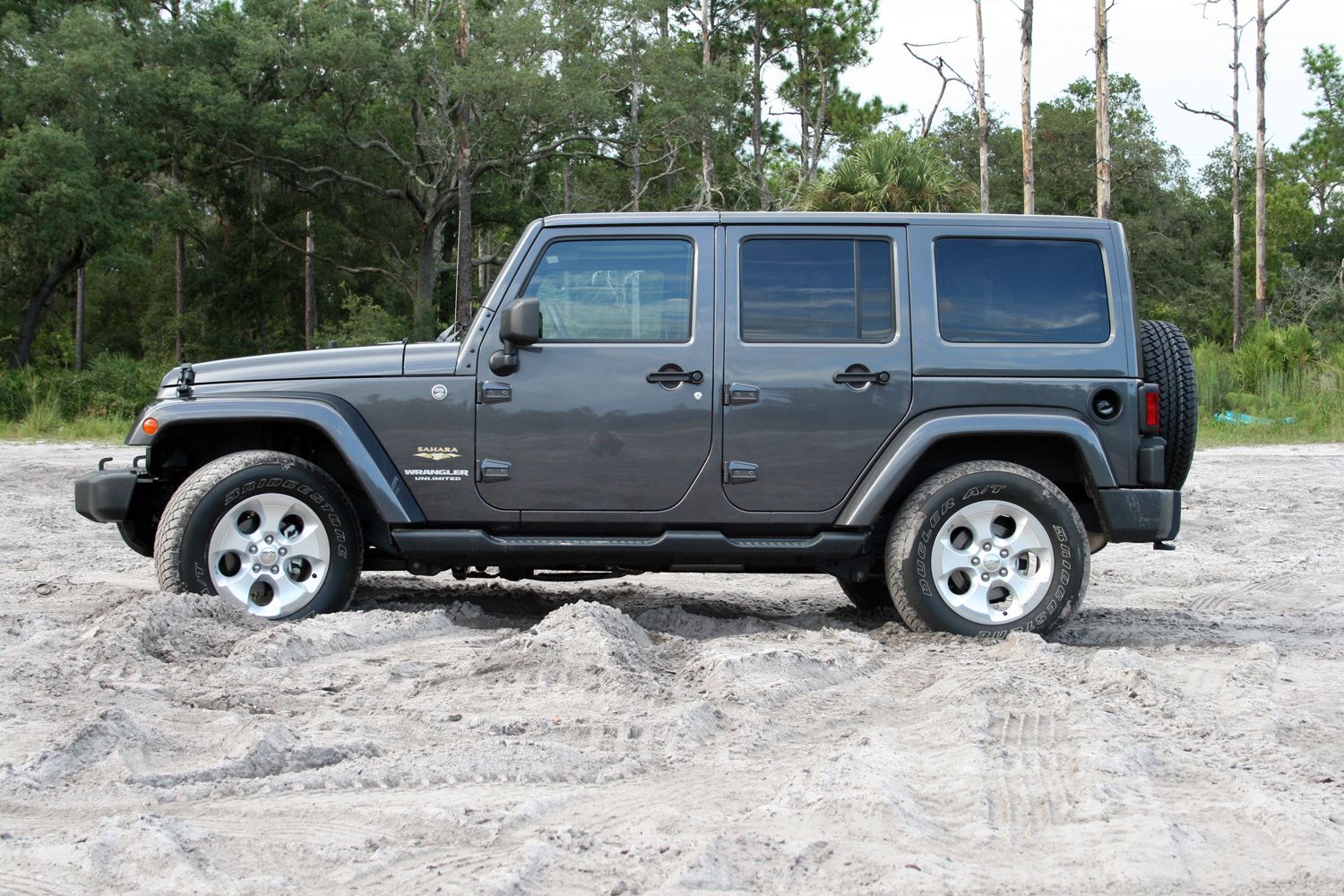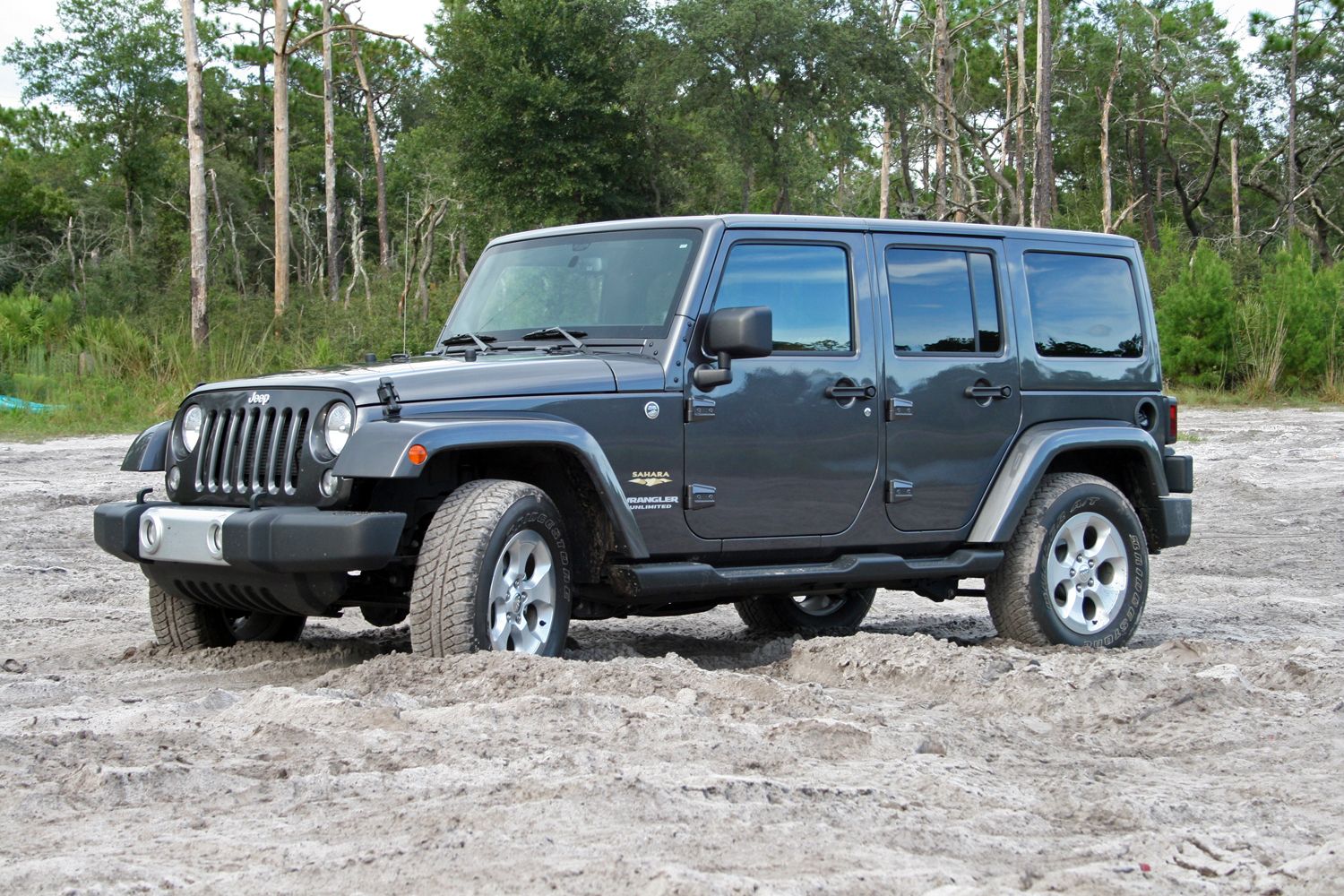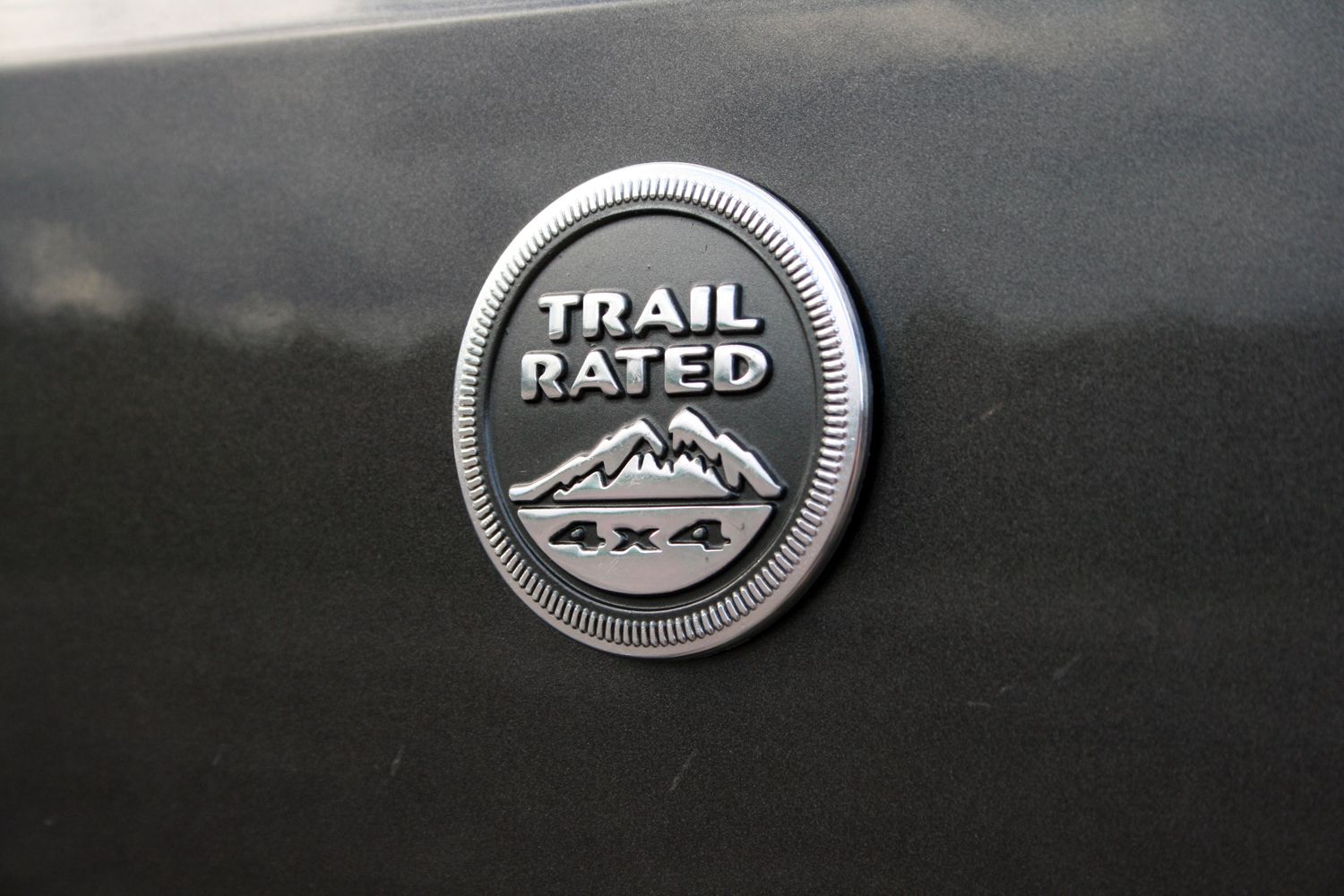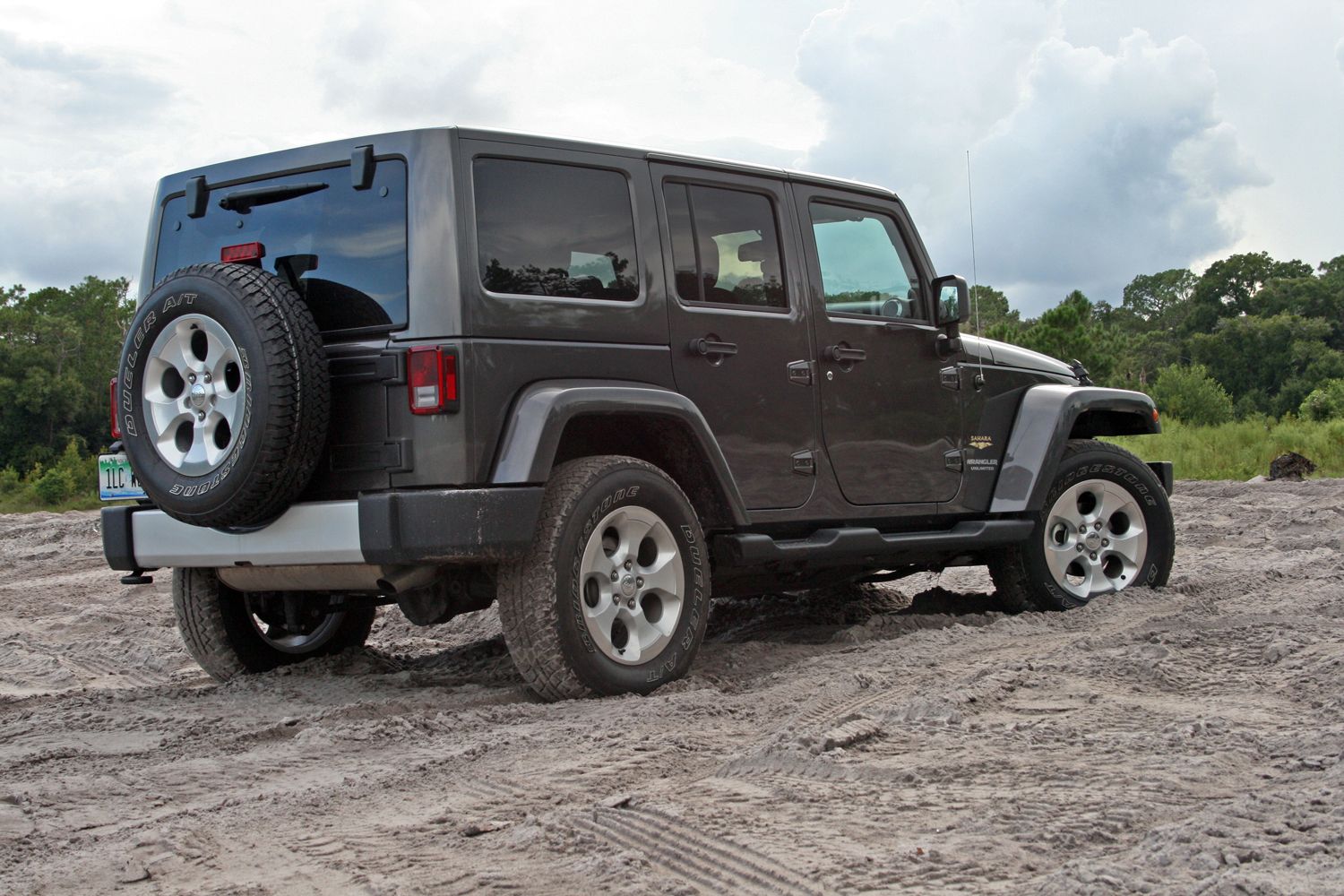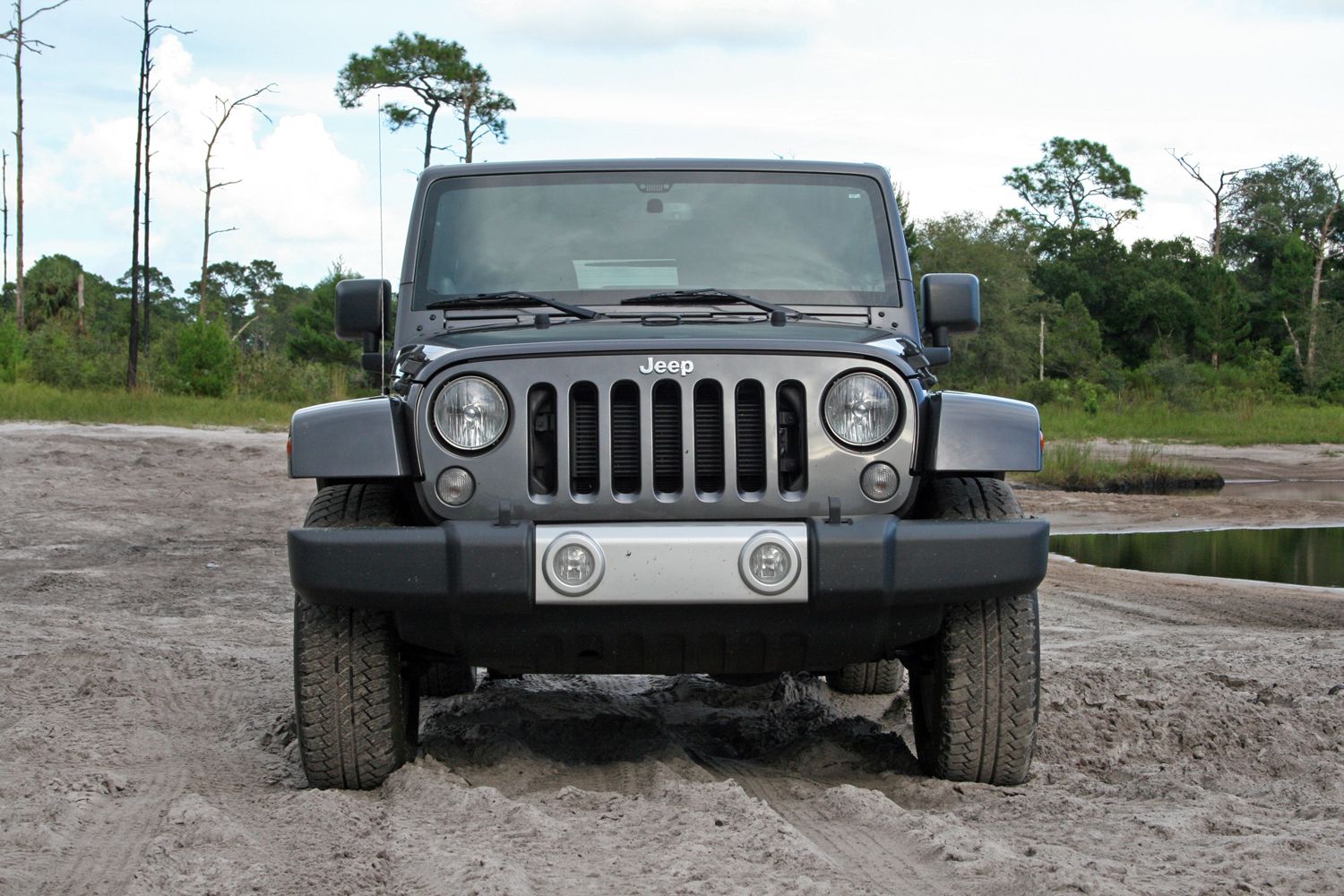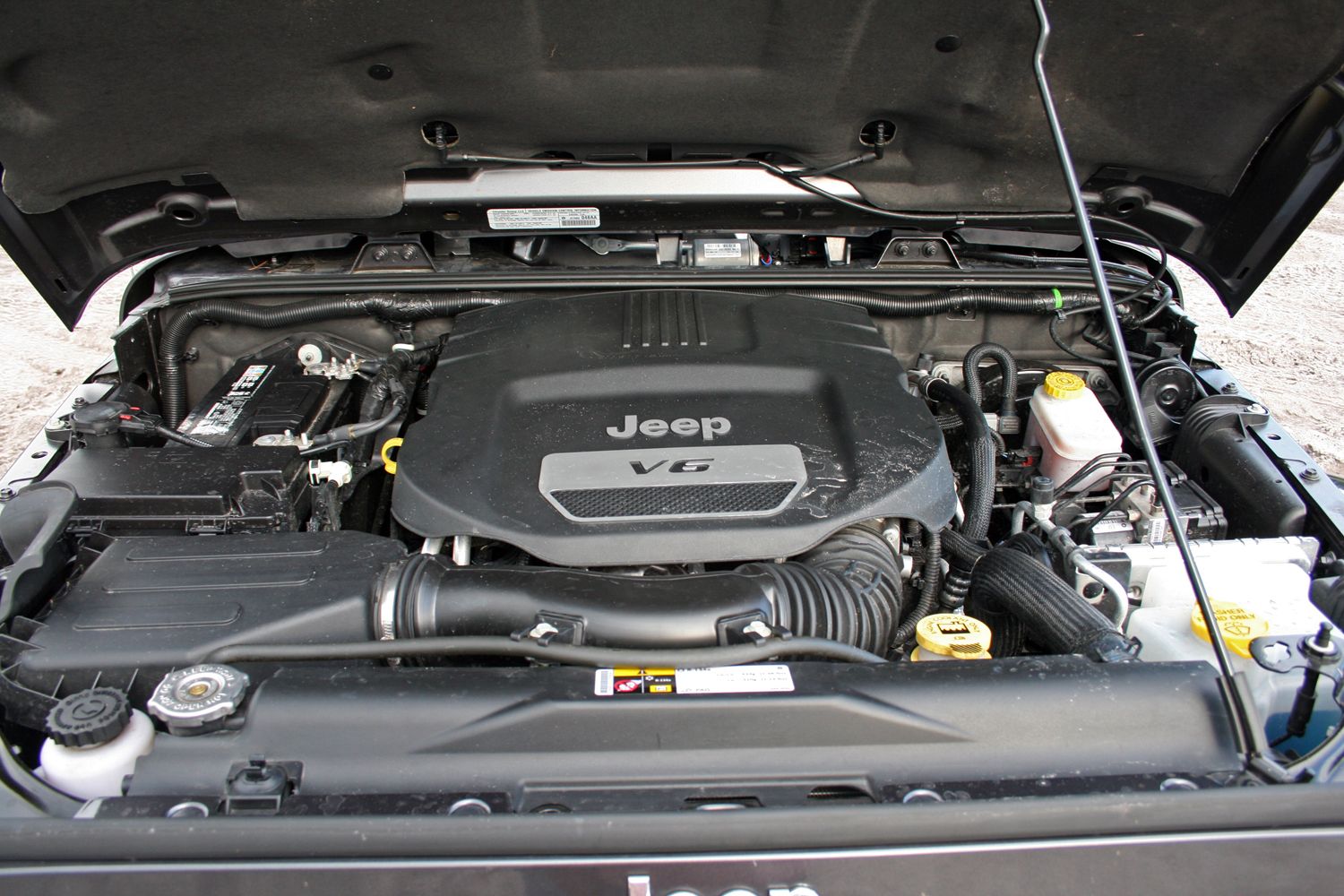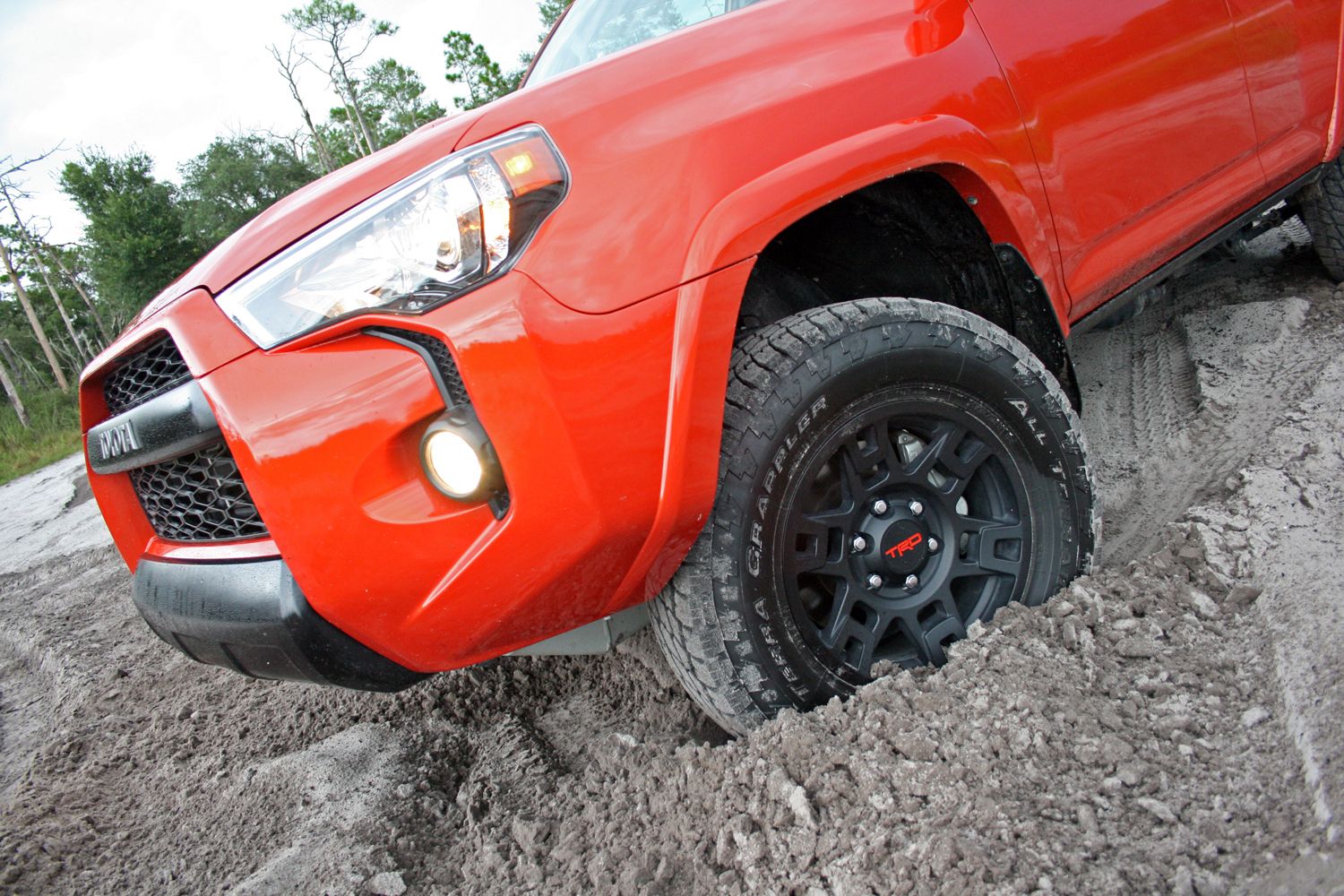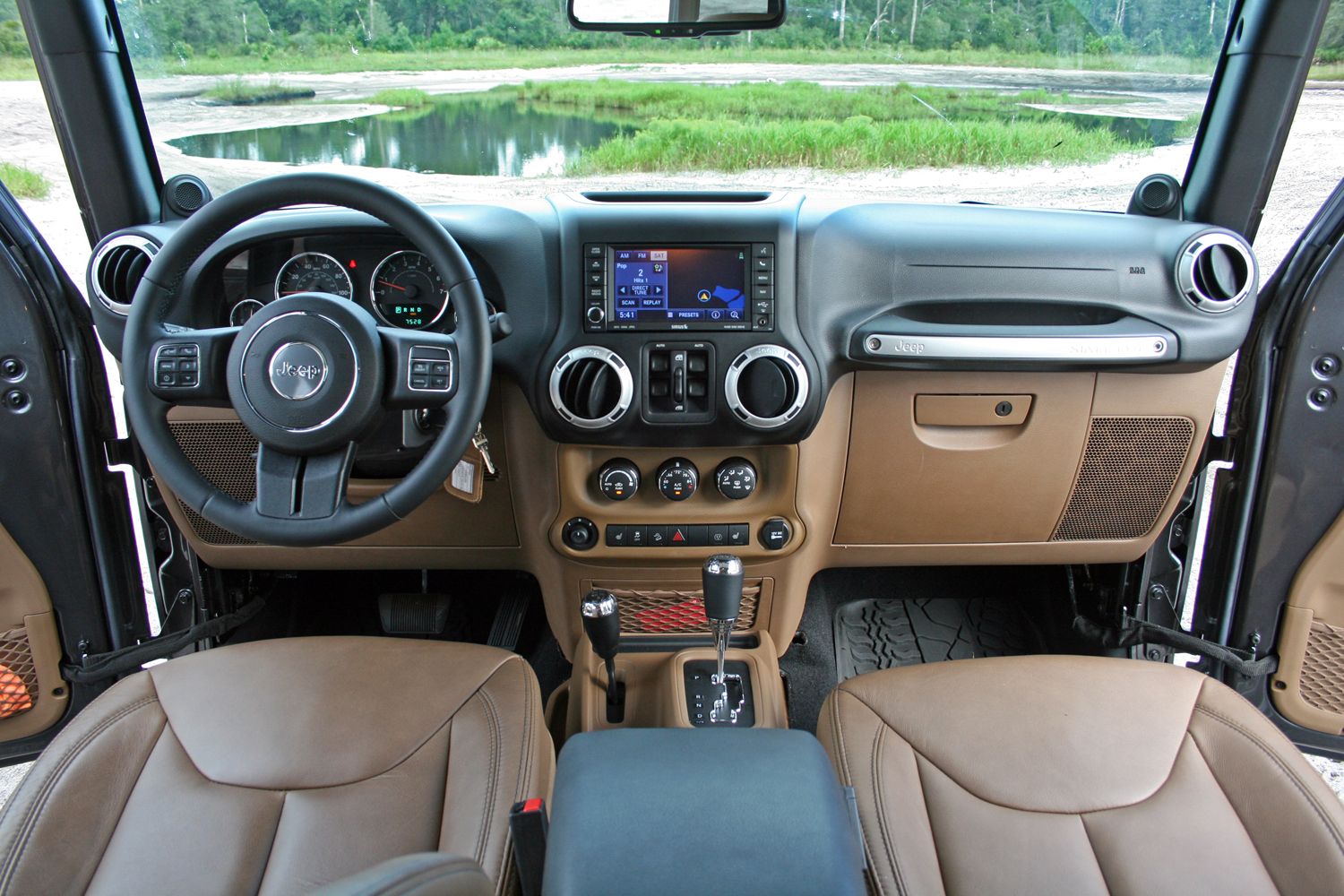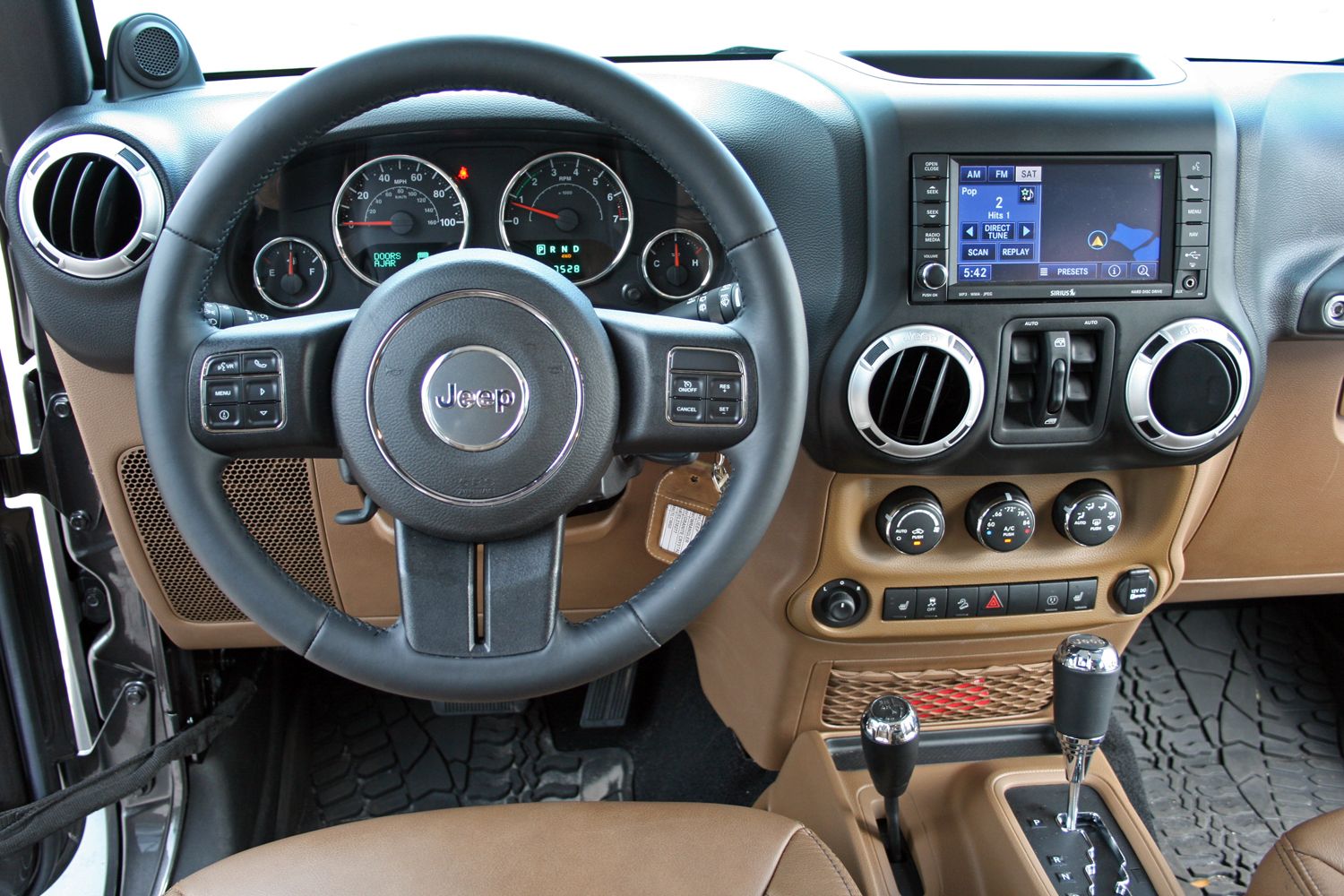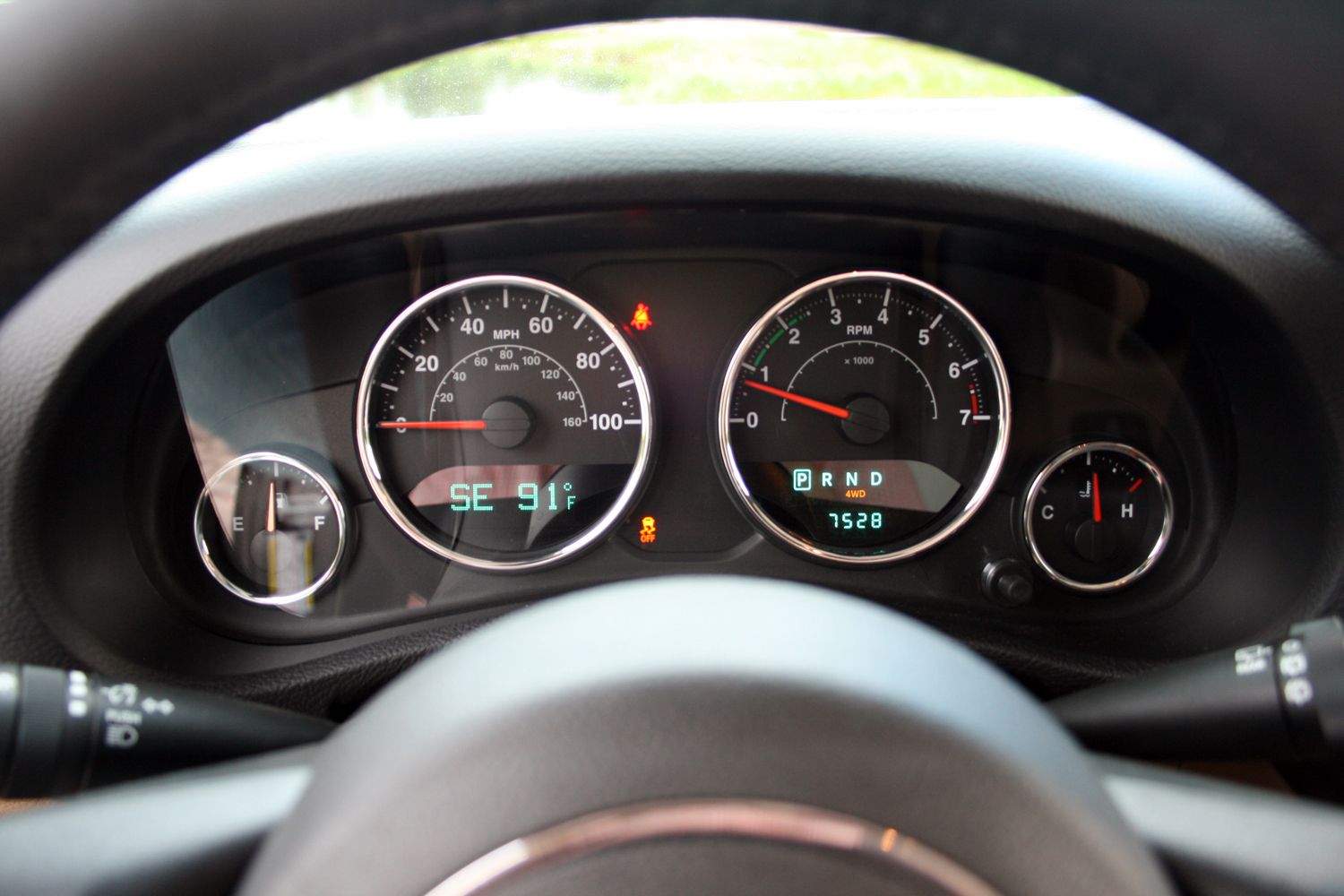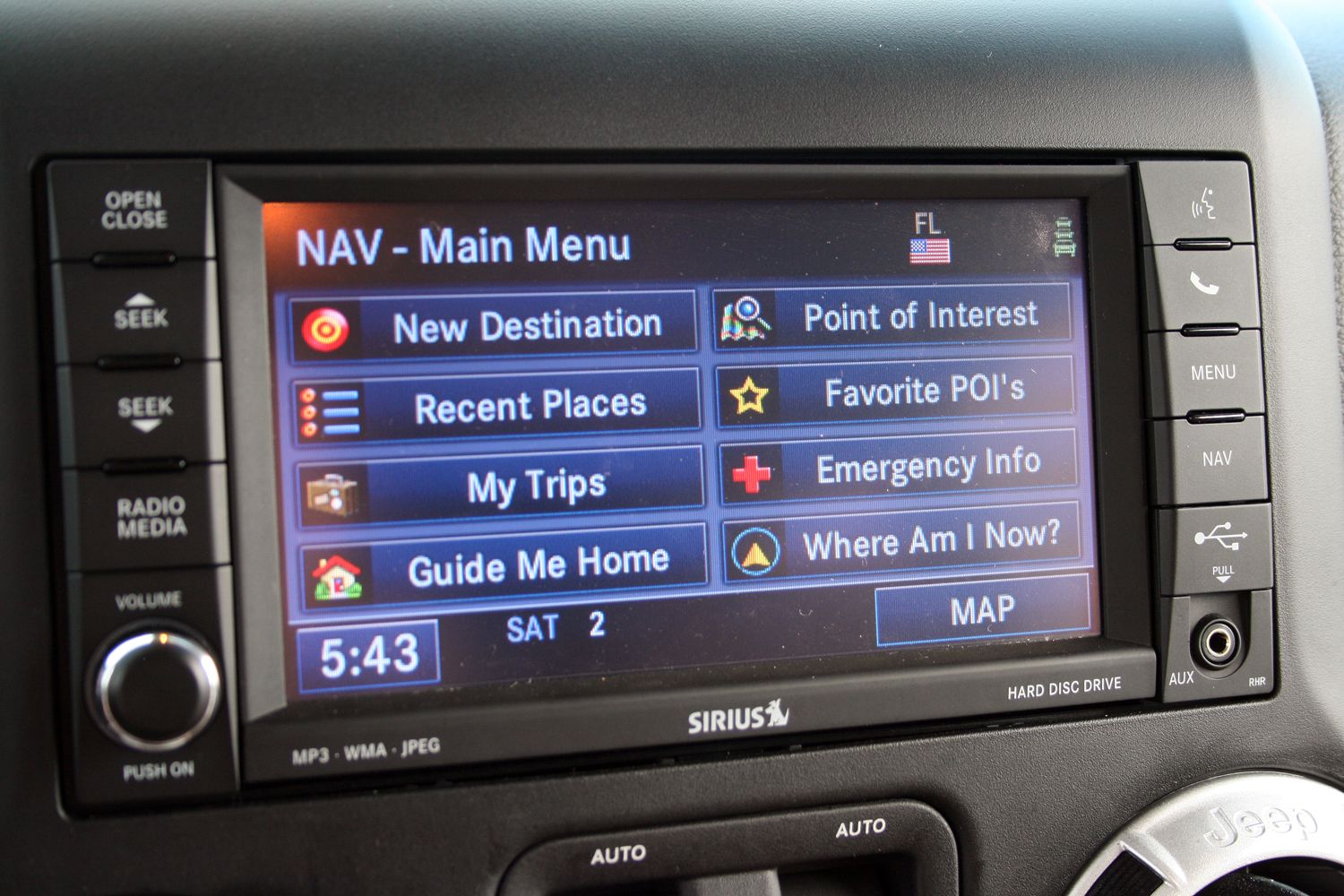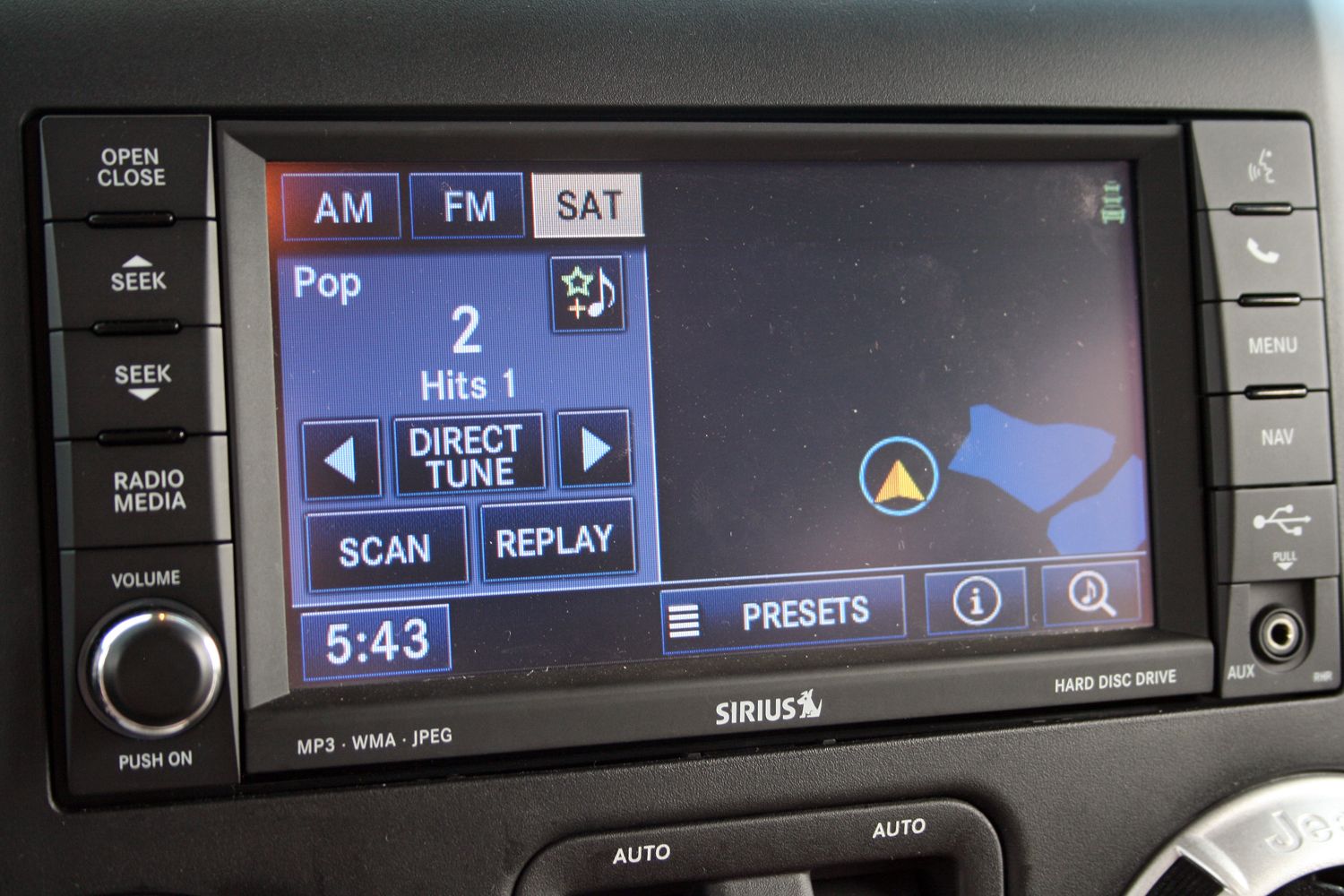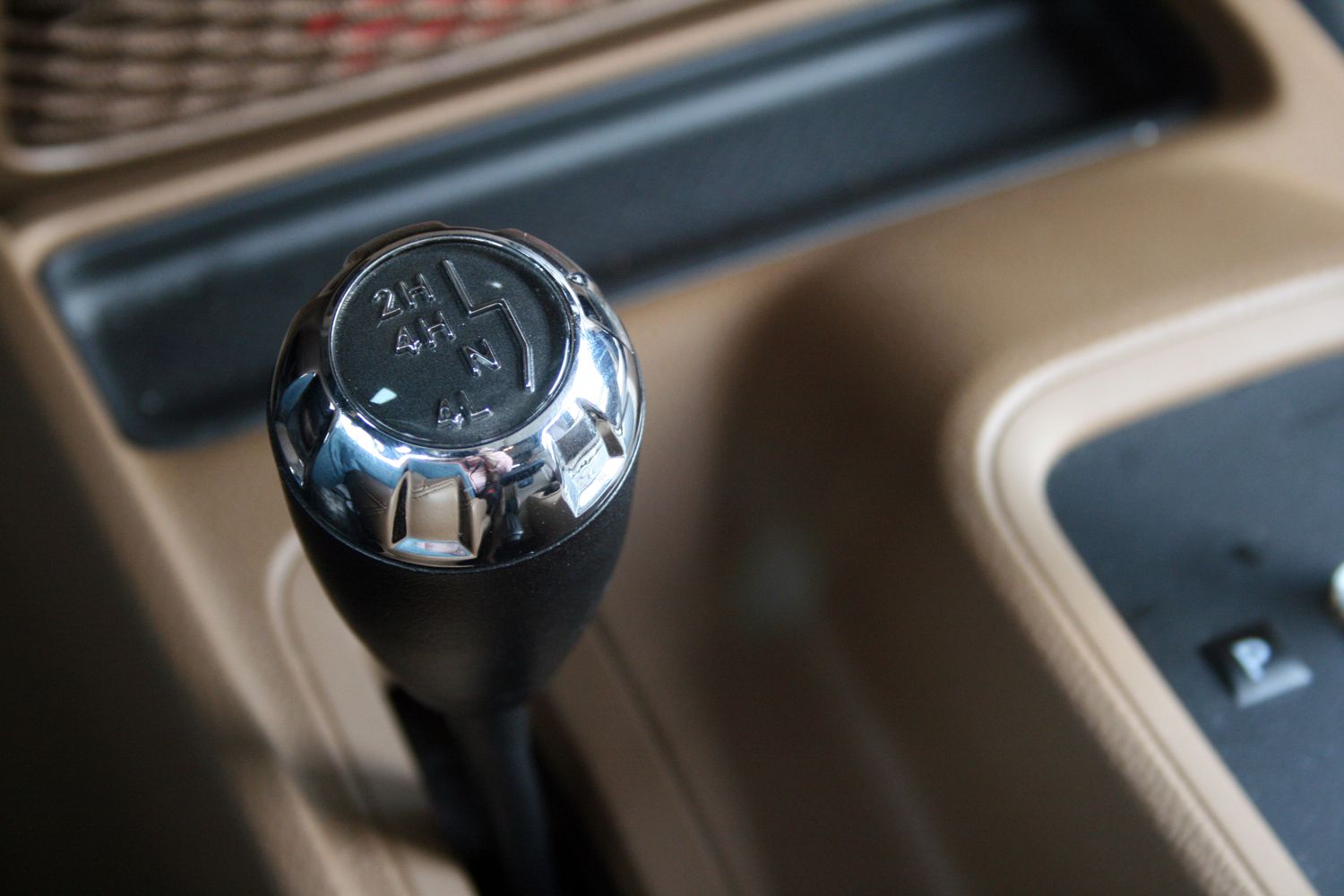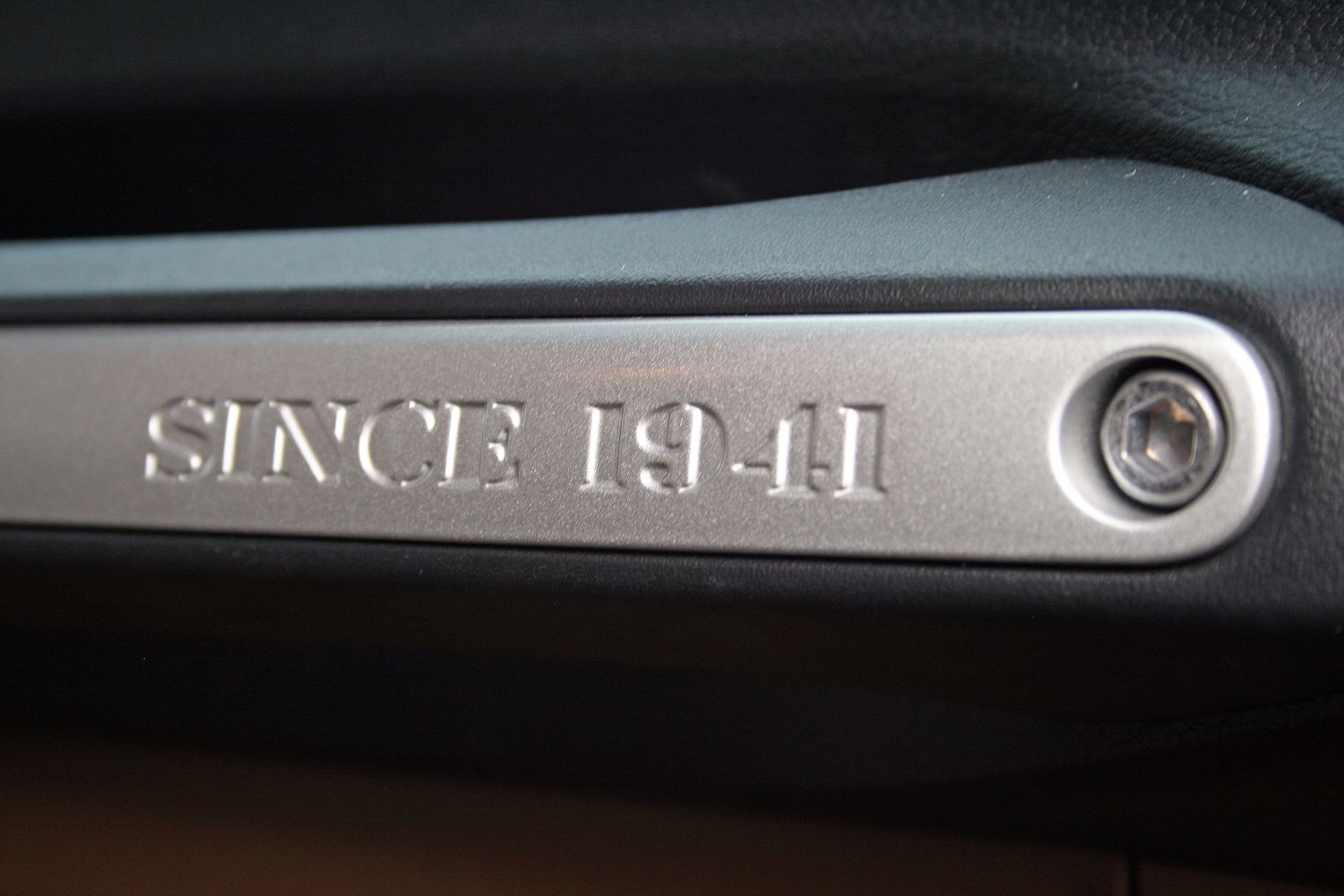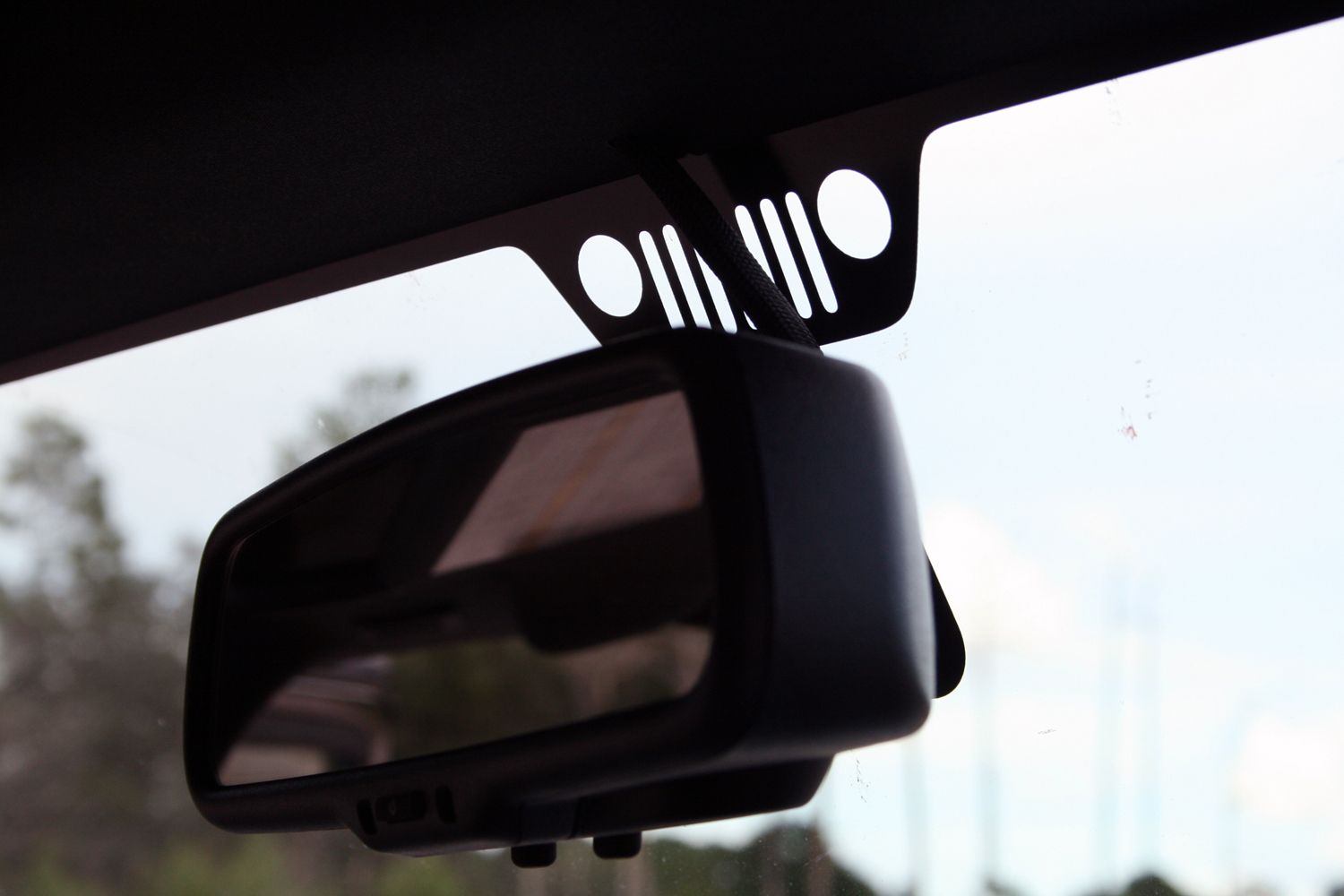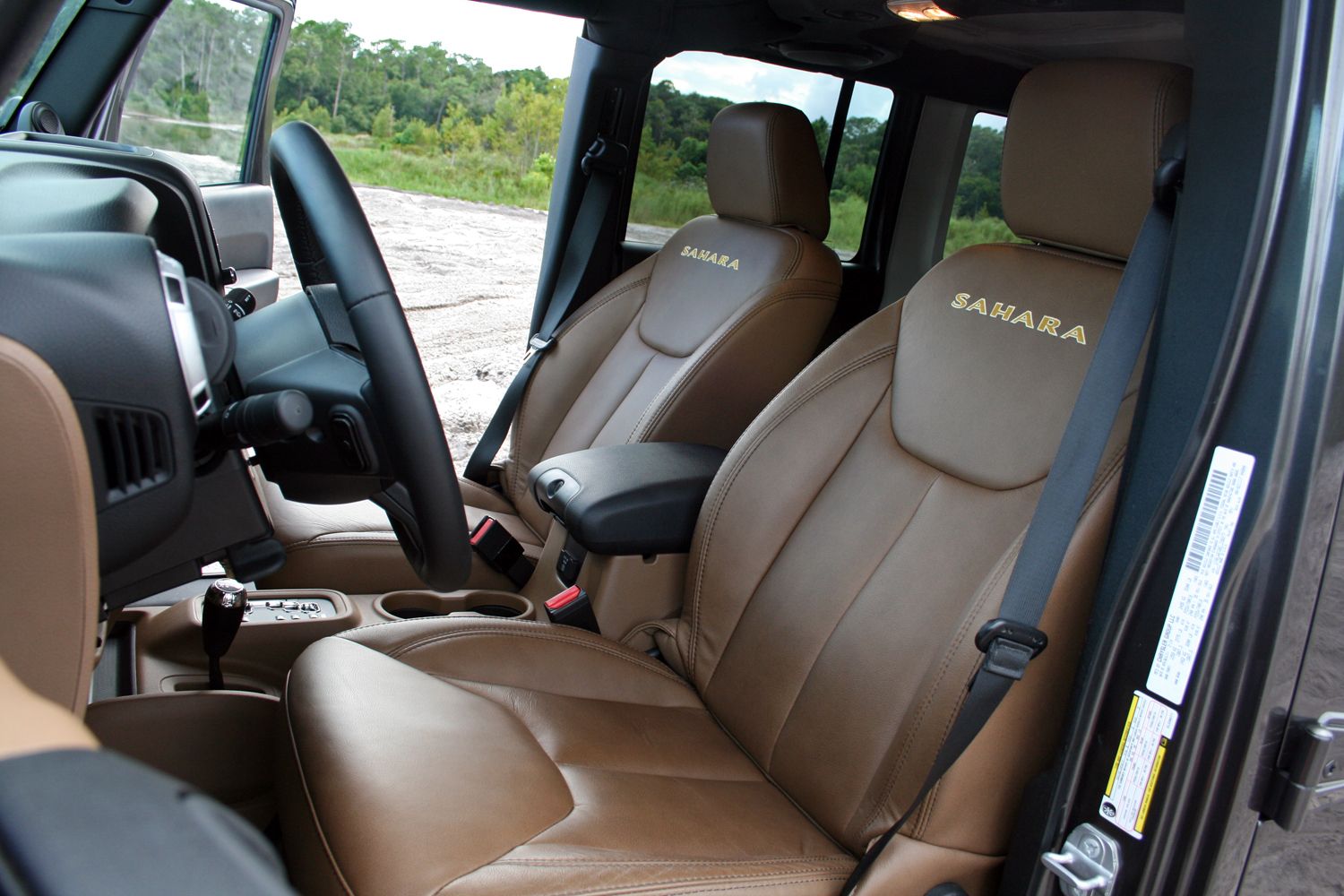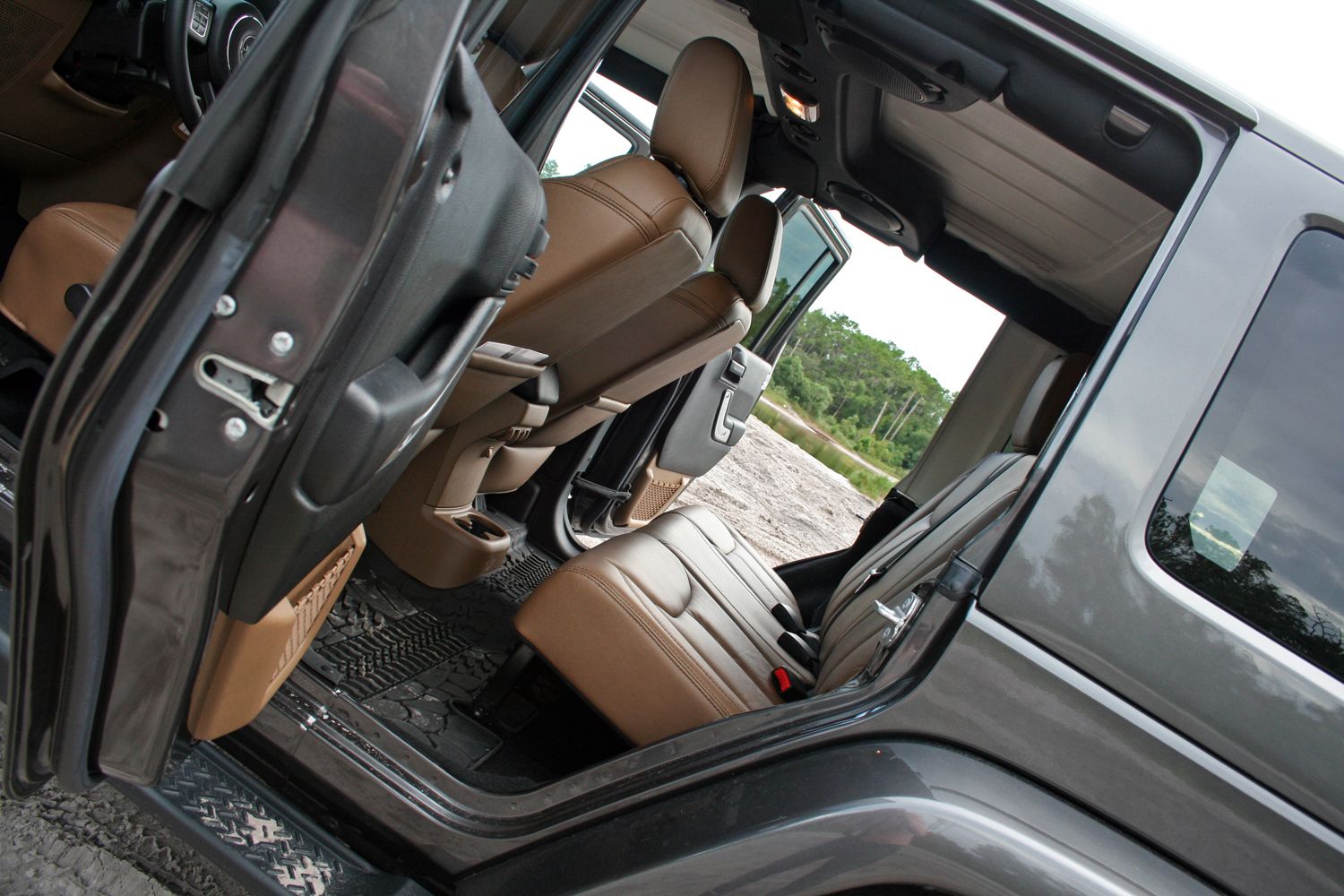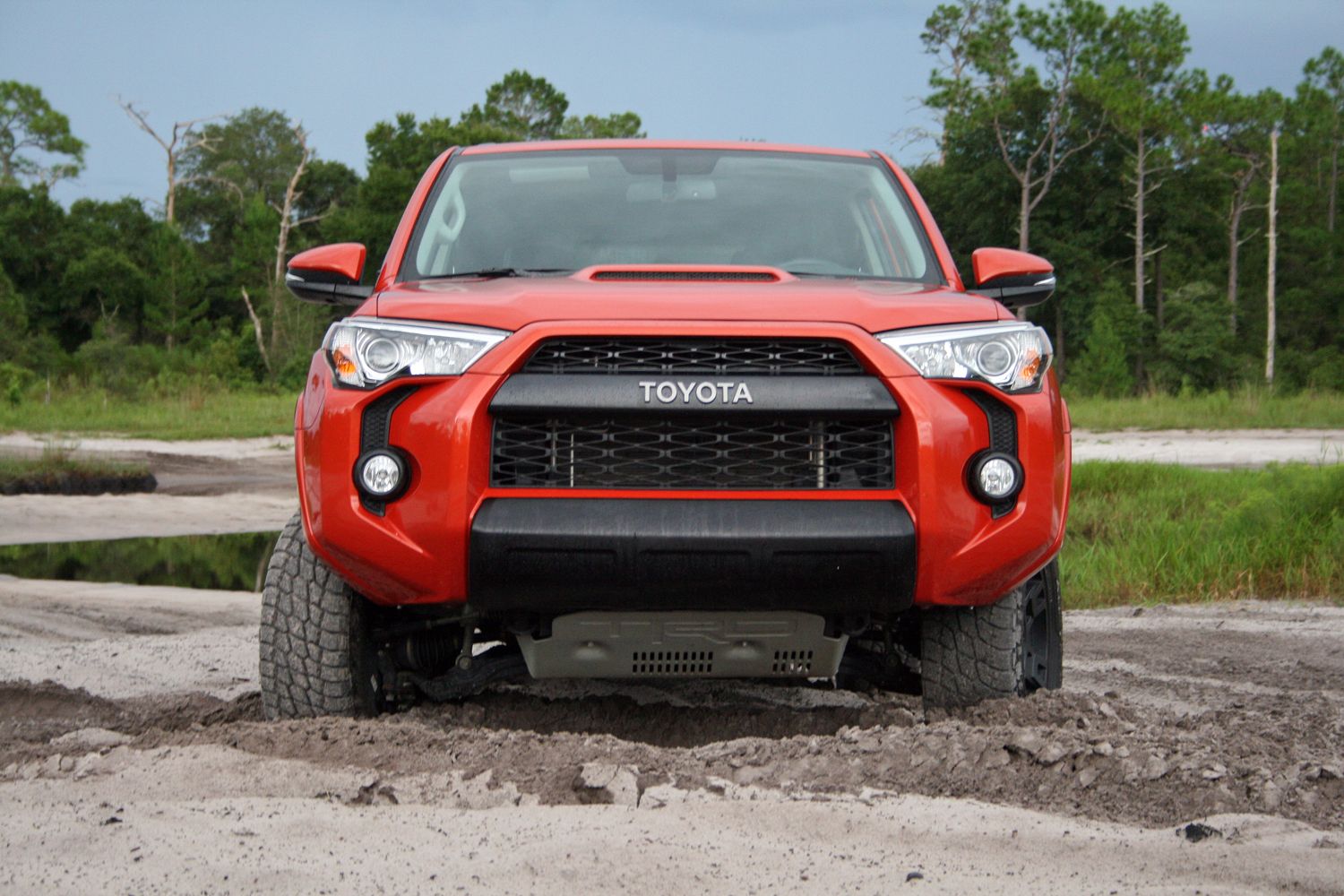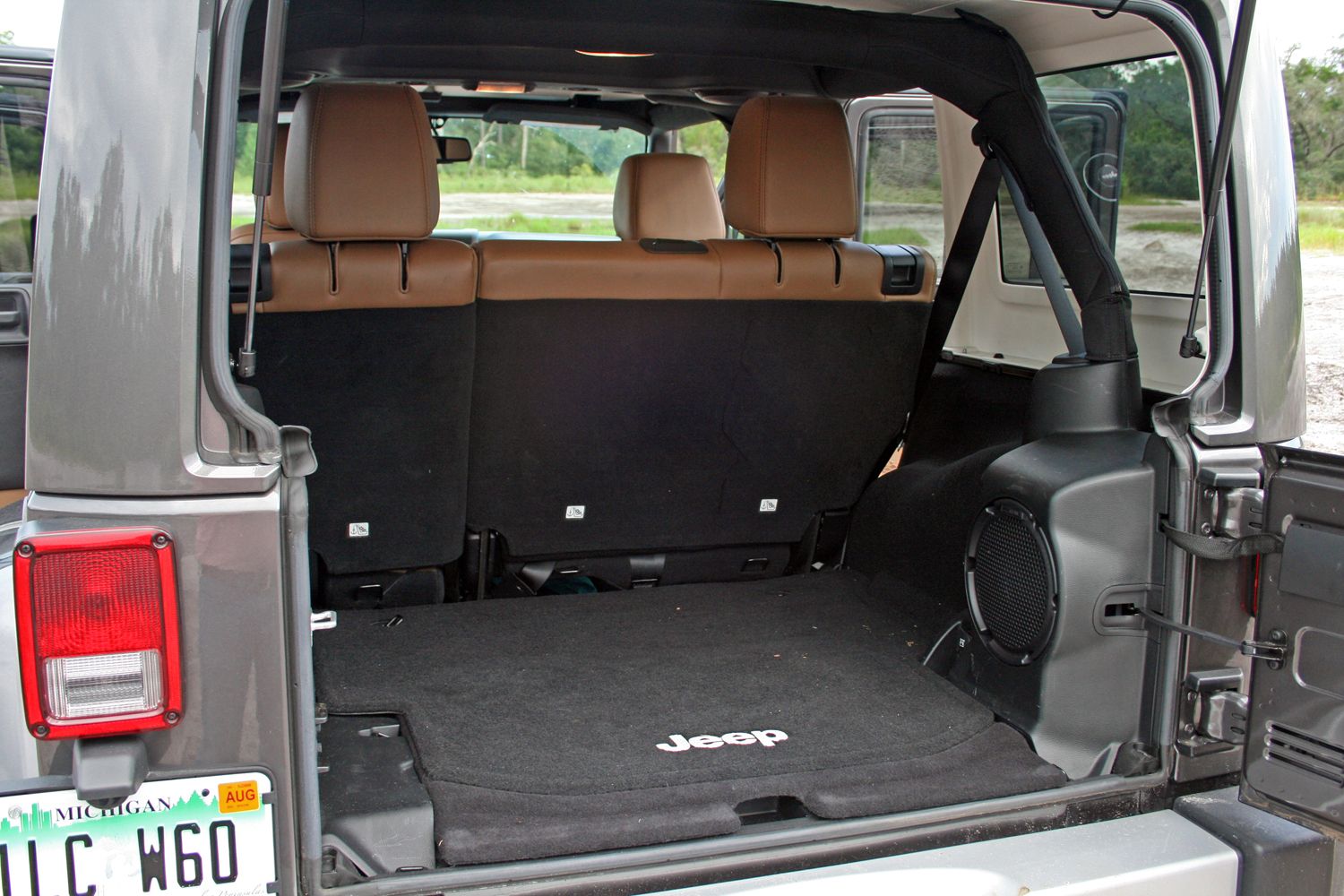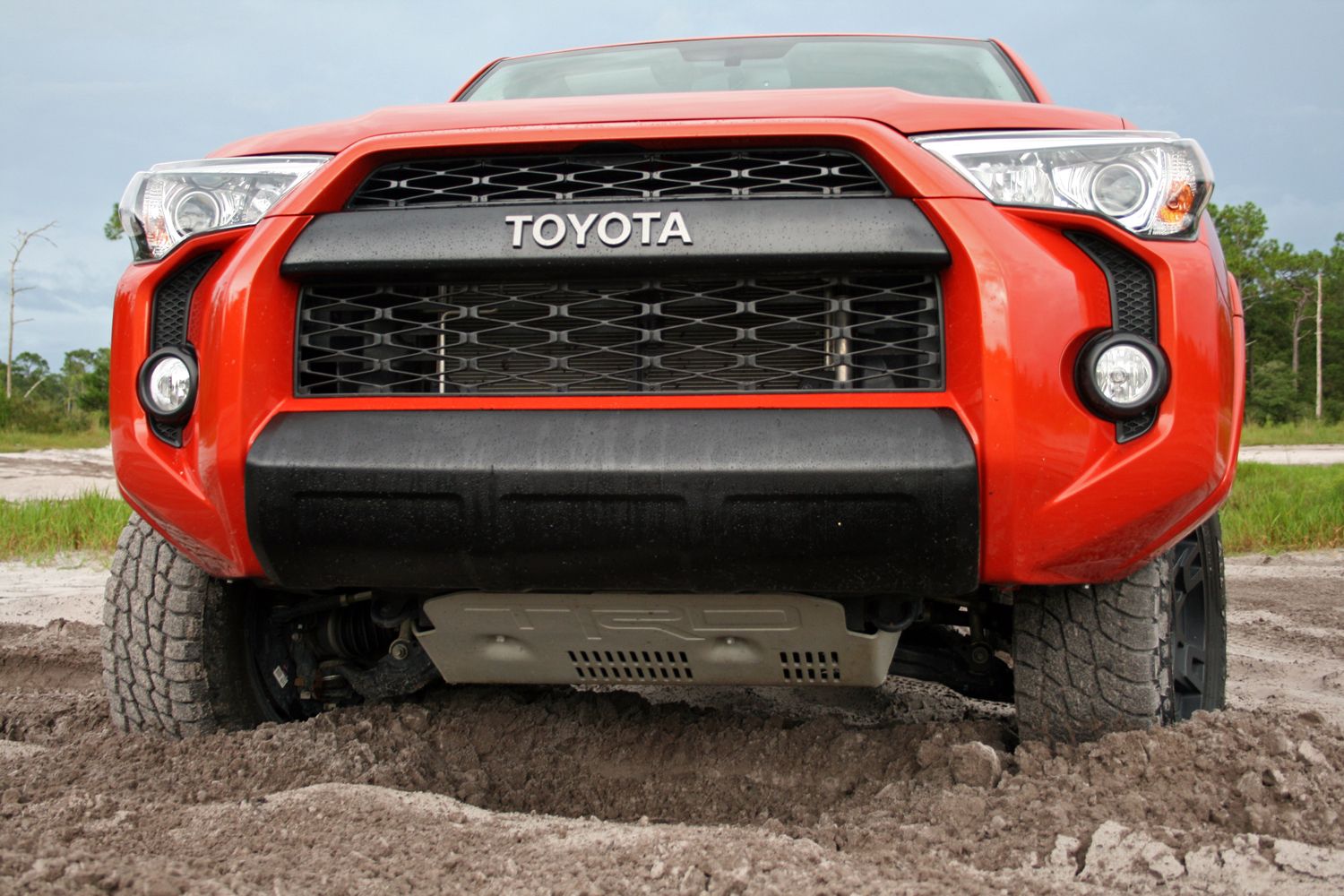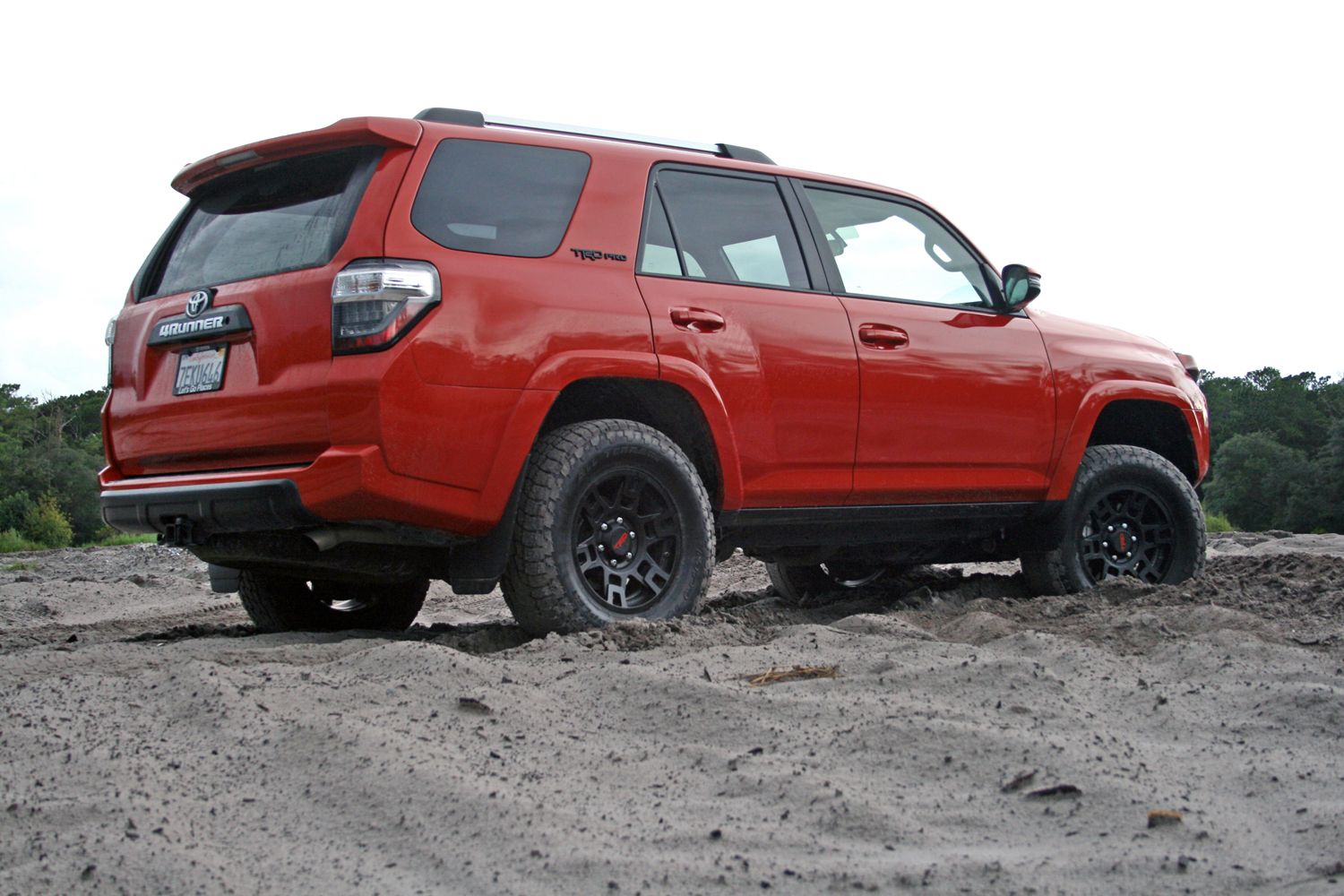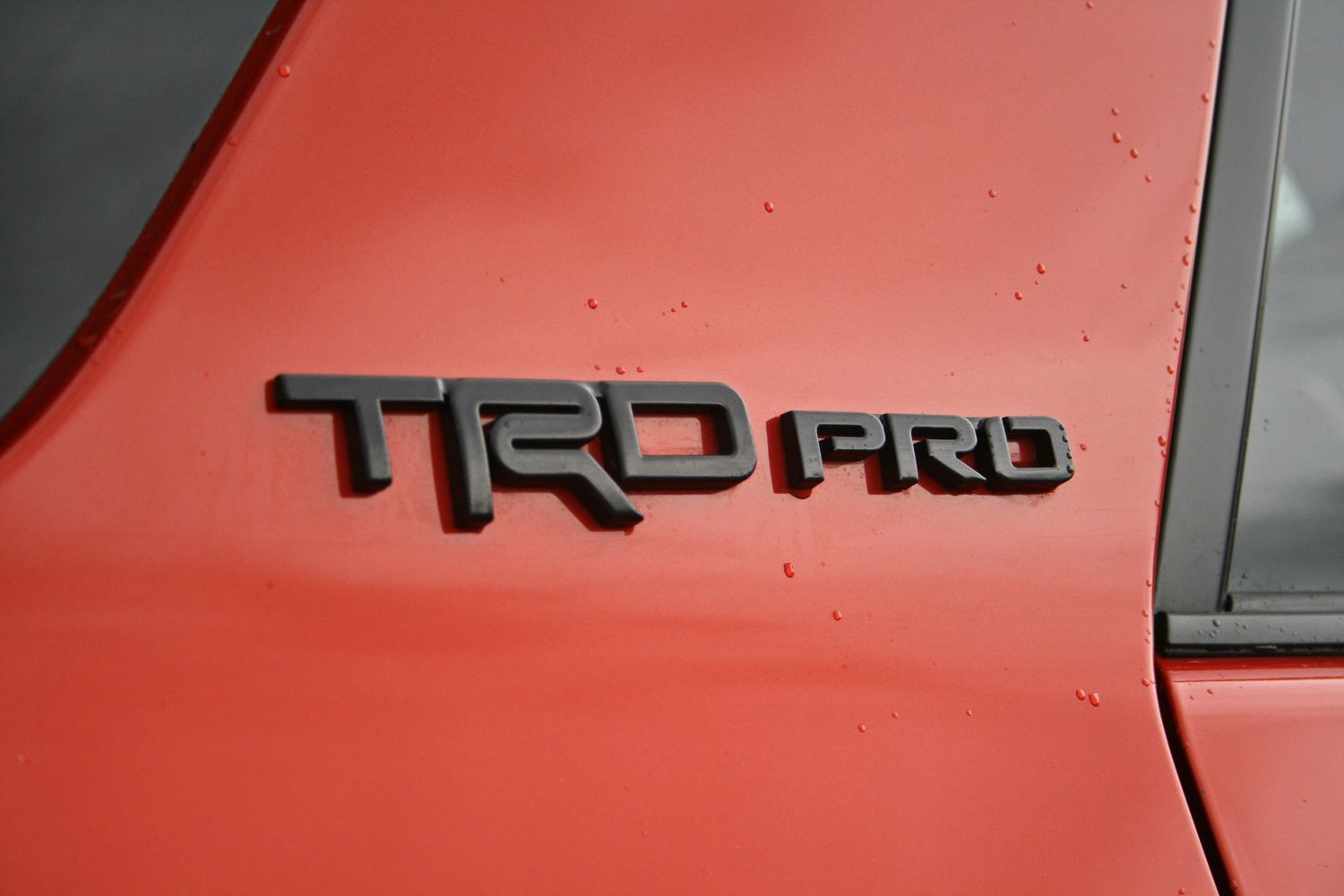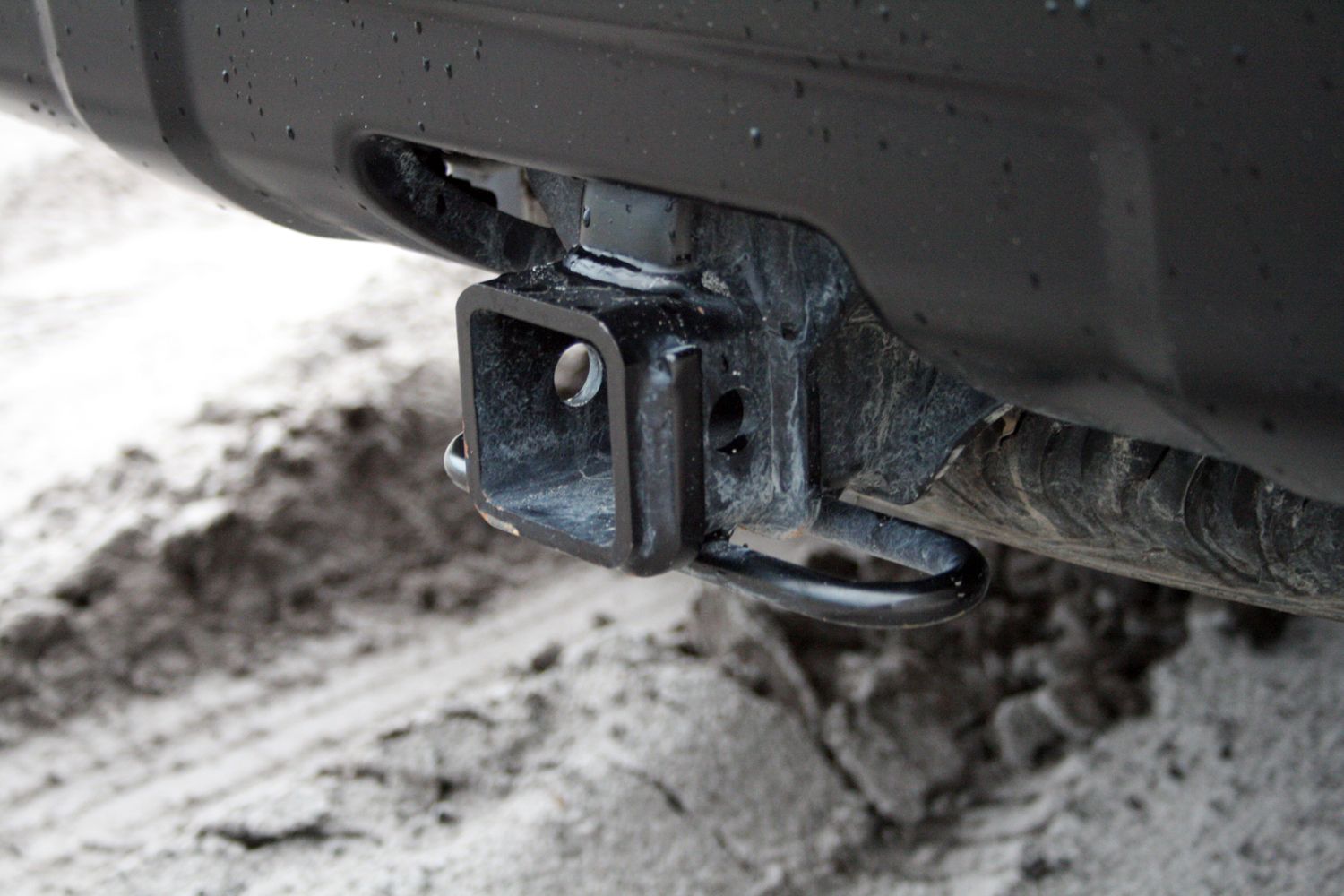The Jeep Wrangler->ke425 has long been the king of off-roading machines. It’s two solid axles, manual transfer case, gracious ground clearance and never-ending supply of aftermarket parts have made the Wrangler the stuff of legend. What’s more, its removable doors and top put passengers closer to the elements and heightens the thrill of the trail.
Of course, for all good champions, a new challenger is never far behind. Enter the 2015 Toyota 4Runner TRD Pro. This is Toyota’s->ke88 latest version of its (almost unchanged) 4Runner design. Thanks to some clever engineering in the Toyota Racing Development labs, the 4Runner->ke1844 now enjoys a truly hard-core off-road version that usurps even the venerable Trail Edition 4Runner.
Heavy duty Bilstein shocks with remote reservoirs, thick coil springs with a 1.5-inch suspension lift, upgraded wheels and tires, and a tank-like front skid plate make the TRD Pro a natural in the dirt. All the same off-road tech on the Trail Edition carries over to the TRD Pro as well. This includes the electronic locking rear differential, manual transfer case, and Toyota’s Multi-Terrain Select system.
Differentiating the TRD Pro series 4Runner from the standard models is a unique front grille with TOYOTA spelled out in block letters. Appropriate TRD Pro badging follows suit, attached on the C-pillars and bespoke TRD Pro wheels. Things inside aren’t much different than other 2015 4Runners, beside a TRD gear shifter and some branded floor mats.
So how does the 4Runner stack up against the stalwart Jeep Wrangler? Head on past the jump for the full rundown and videos.
Click past the jump for the full Wrangler vs. 4Runner battle
2014 Toyota 4Runner TRD Pro vs. Jeep Wrangler Unlimited
- Make: Array
- Model: 2014 Toyota 4Runner TRD Pro vs. Jeep Wrangler Unlimited
- Engine/Motor: Volvo-Penta Saildrive D1-30
- Horsepower: 15
- [do not use] Vehicle Model: Array
Before I continue, we need to adjust some expectations. The Wrangler test vehicle here is the Sahara edition, Jeep’s->ke40 cushier model that lacks most of the really extreme off-road equipment found on the more capable Wrangler Rubicon. While I’m still comparing apples to apples in this test, it’s a nit like comparing a Granny Smith to a Red Delicious – extremely similar, just not quite identical.
The Wrangler is built for fun outdoors. Removable carpet gives way to metal floors with drain plugs, the doors come off with two nuts and a wiring connector, and the hard top comes with T-Top-like panels that stow in the cargo area for topless rides. A few more bolts and the remainder of the hard top can be left at home. If you really feel the outdoors calling (and you’re not on a public road) the windshield will even lay flat across the hood. You’d have to buy a motorcycle to get any more "open-air."
This type of experience can be extremely fun. Believe me, as soon as the late summer monsoon season that Florida endures eased up, the doors and Freedom Top roof panels came off. However, Jeep owners know having this sort of open-air capability comes at a price. Even with all exterior panels in place, wind noise is a prevalent issue at highway speeds. It’s actually not terrible, but compared to the 4Runner, its downright breezy.
The Jeep also suffers from a less refined ride. The solid axles transmit every bump and the steering is somewhat vague on center. Interior comfort is also spartan, especially in light of this Sahara edition’s $40,280 price tag. Though the interior is far improved over the 2007 trough 2010 JK models, the dash and center console materials still suffer from low-grade plastics. Perhaps one of the greatest complaints about the Wrangler’s interior surrounded the outdated 730N-series Uconnect system. Clunky menus and slow-to-respond soft buttons make using it an annoyance. Hopefully Chrysler will give the Wrangler the very much-improved 8.4 Uconnect with the upcoming generation change. Otherwise, physical ergonomics are actually pretty good inside the Wrangler.
Like all Wranglers, the Sahara is powered by Chrysler’s ubiquitous 3.6-liter Pentastar V-6. In this case, it makes 285 horsepower and 260 pound-feet of torque. The engine feels leagues better than the old, unrefined 3.8-liter V-6 of old, but the lack of substantial NVH blockers allow the occupants to feel exactly what the engine is doing. Power is on par with the 4Runner, thought the Jeep’s throttle left a lot to be desired. It required a lot of input before changes happened under the hood. That’s fine off road, but it gets tiring when commuting around town.
The 4Runner on the other hand is a very comfortable place to be. The interior is quiet, aided by soft touch leather and high-grade plastics. The more car-like cabin features plenty of cubbyholes and storage pockets. Large knobs and switchgear remind then you of what the 4Runner’s intent is, and an easy-to-read gauge cluster and center information display keep pertinent information readily accessible. The Entune infotainment system follows the standard Toyota fare, being easy to operate and decently designed. A small information screen atop the center stack keeps fuel, outside temperature, direction, and time always within sight.
Rear seat room is also more comfortable than the Wrangler. The seatbacks recline at a deeper angle for a more relaxed ride while legroom is more generous. The 4Runner and Jeep do share the ability to fold the rear seats for more storage.
On the road, the 4Runner TRD Pro acts very similar to the Trail edition 4Runner I tested a few months back. Steering inputs are welcomed with a light touch and throttle feel is appropriate, but the brake pedal is a tad spongy, making them a little slow to bite. Body roll is well managed in the corners thanks to the beefy springs. It doesn’t handle like a sports car, but it doesn’t list like a lifted SUV either.
The 4Runner is motivated by the same 4.0-liter V-6 that lives in nearly every other Toyota truck product. In this application, it makes 270 horsepower and 278 pound-feet of torque. While it’s technically down on power compared to the Jeep, the 4Runner’s responsive throttle makes the most of the four-liter. Acceleration comes more quickly, giving the 4Runner the edge in thick city traffic.
Wrangler Unlimited Sahara Off Road
Despite its on-road flaws, the Wrangler does an impressive job when the pavement ends. Its tough underside is covered in skid plates ready to deflect rocks and sticks. Even the hard plastic running boards do a good job at keeping the rocker panels protected. Axle hop on soft sand is very well controlled. The Sahara’s stock Bridgestone tires are definitely more street-biased, but do ok in sand and light mud, even at full pressure. A set of meatier all-terrains would do wonders for the Wrangler’s performance. Then again, that’s where the Rubicon model comes in. If you’re actually one of the folks who plan on using their Wranglers off road and don’t want to go the aftermarket route, the Rubicon is the better solution.
4Runner TRD Pro Off Road
As expected, the 4Runner TRD Pro proved to be a great vehicle for hitting the weekend trails. The large Nitto Terra Grappler tires did a great job a paddling through deep mud and lose sand at full pressure. They do pack mud like all-terrain tires, but also do a good job at self-cleaning. The TRD suspension with its remote reservoir Bilstein shocks do an amazing job at soaking up bumps, and the thick skid plate up front inspires confidence (foolishness) for attacking obstacles with speed. In fact, speed works in the 4Runner TRD Pro’s favor as the suspension is able to take the abuse and the tires aren’t up to mud-terrain standards.
The 4Runner proved to be a better all-round vehicle in terms of everyday livability and weekend off-road prowess. Its specialized suspension gives it freedom in the dirt, but doesn’t hinder its on-road performance. Unlike the Wrangler that sacrifices creature comfort for its stellar four-wheel-drive performance, the 4Runner somehow combines the two in a seamless manner.
Conclusion
Just like putting lipstick on a pig, the Sahara edition doesn’t change the fact the Wrangler is a hard-core off-roader to its soul. That characteristic shines through no matter what terrain the Jeep rolls across, for better or worse. The 4Runner on the other hand, is like putting bacon on a sandwich. It was good to begin with, but with the added goodies, it performs all the better. The 4Runner is the more competent on-road handler yet still outperforms the Sahara edition Wrangler on the trail. Much of that can be attributed to the TRD Pro’s more aggressive tires and upgraded suspension.
The Wrangler Rubicon version would be more equally matched to the 4Runner TRD Pro’s prowess in the dirt, but the upgrade wouldn’t change the Jeep’s rough and tumble interior and less than stellar Uconnect system. From the driver’s prospective, the 4Runner is just a more comfortable vehicle on and off the road.

